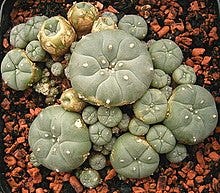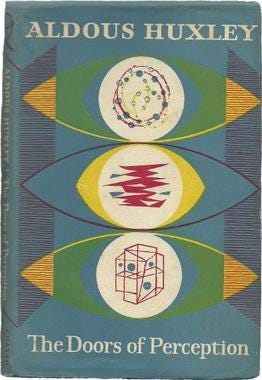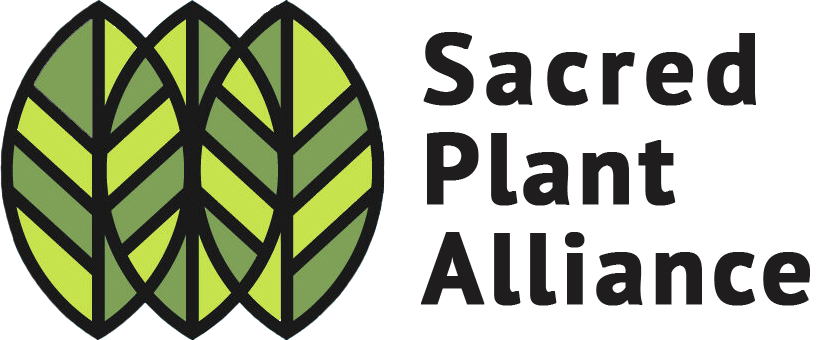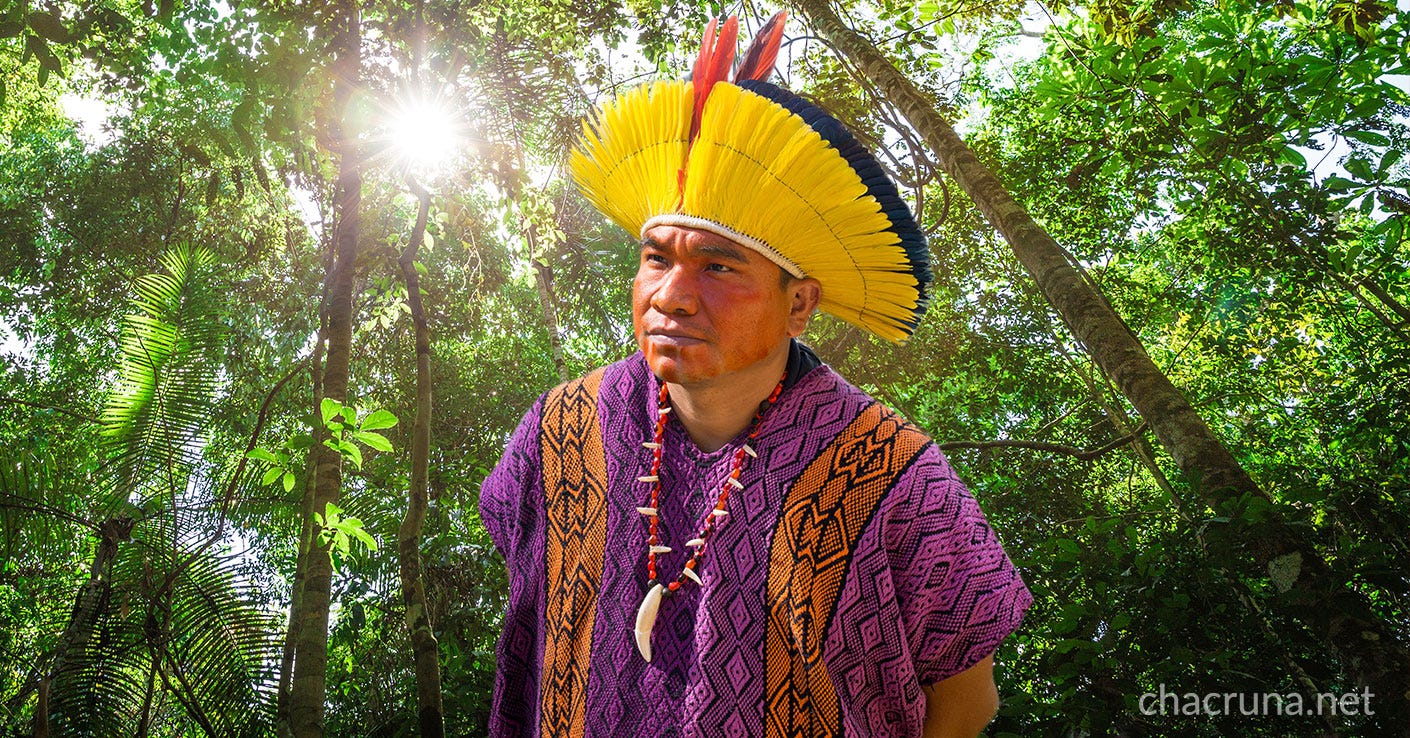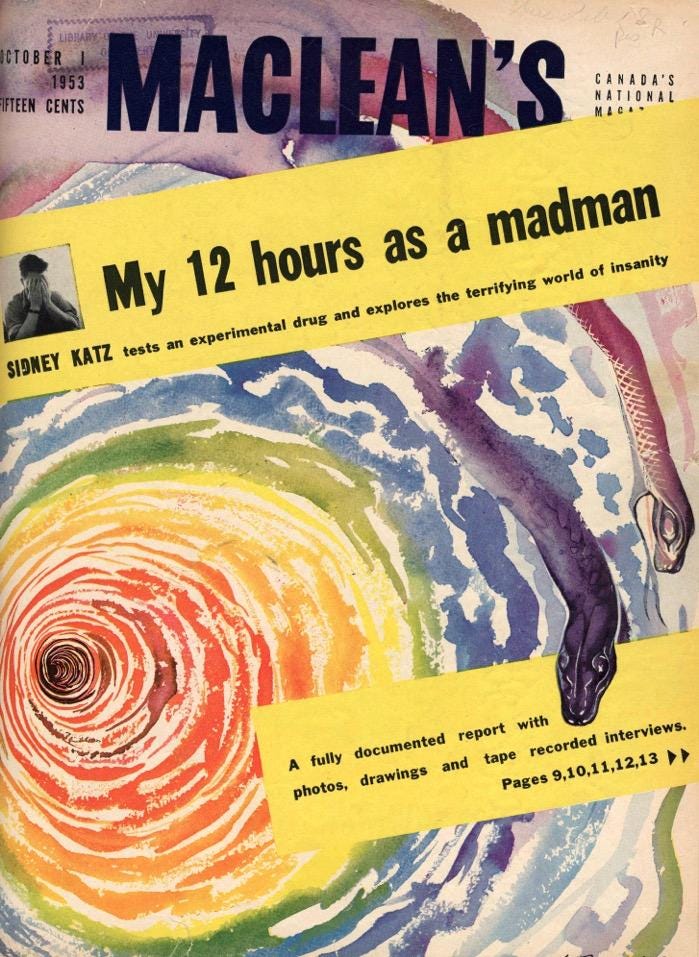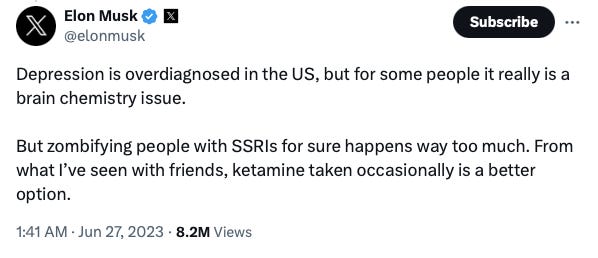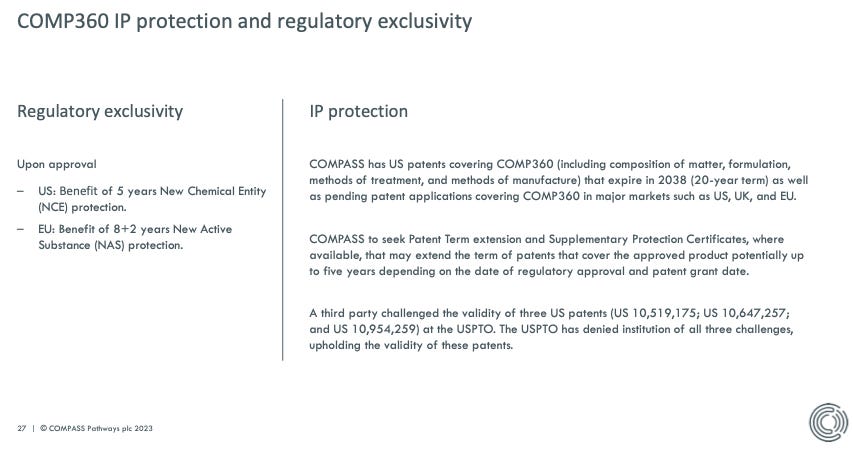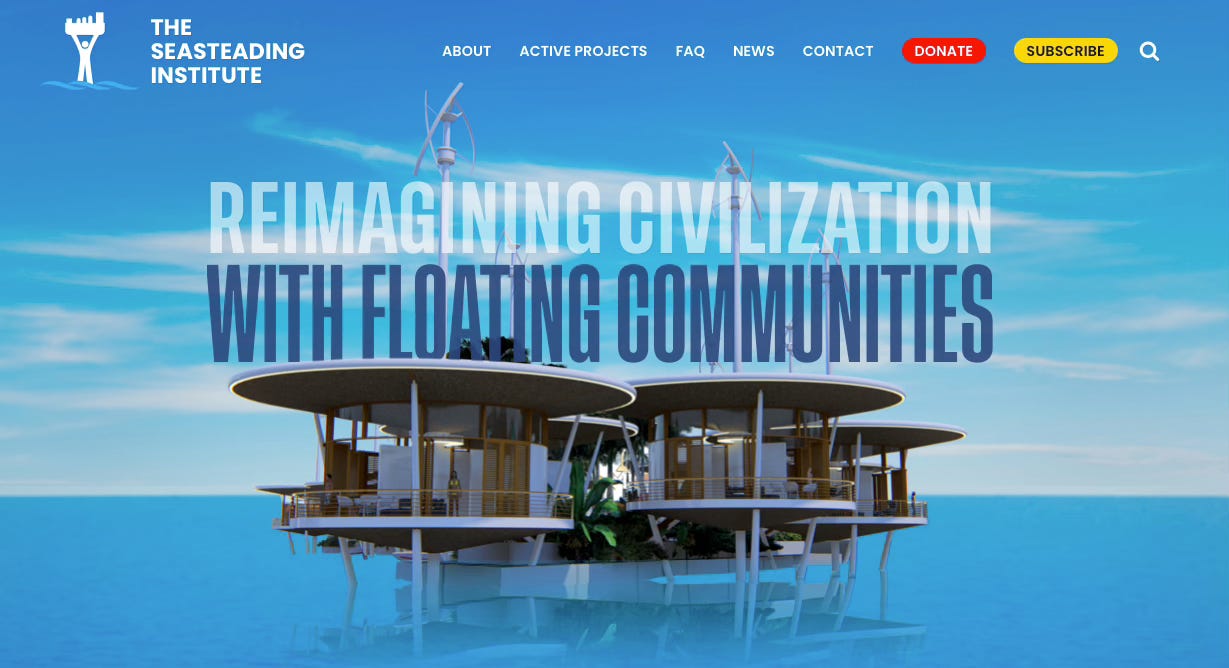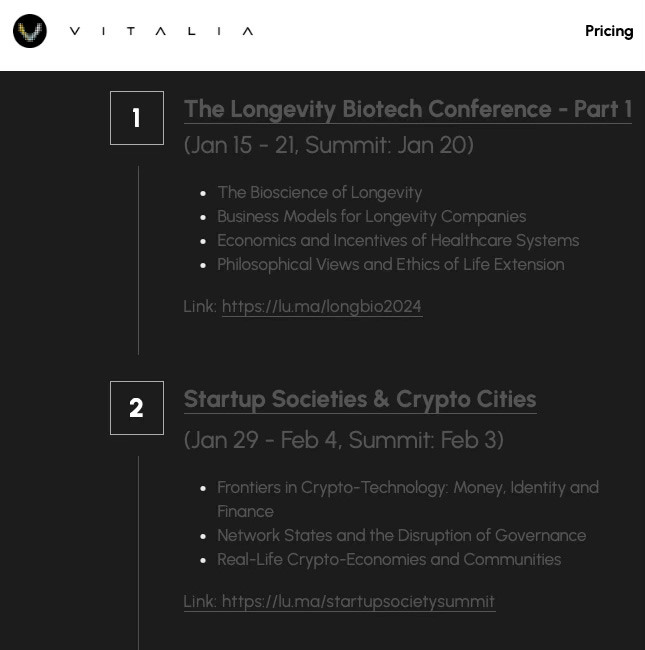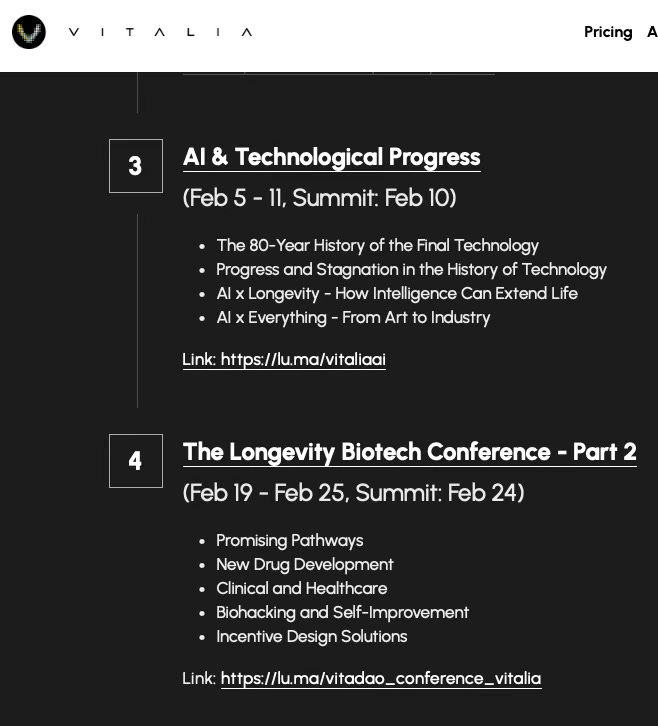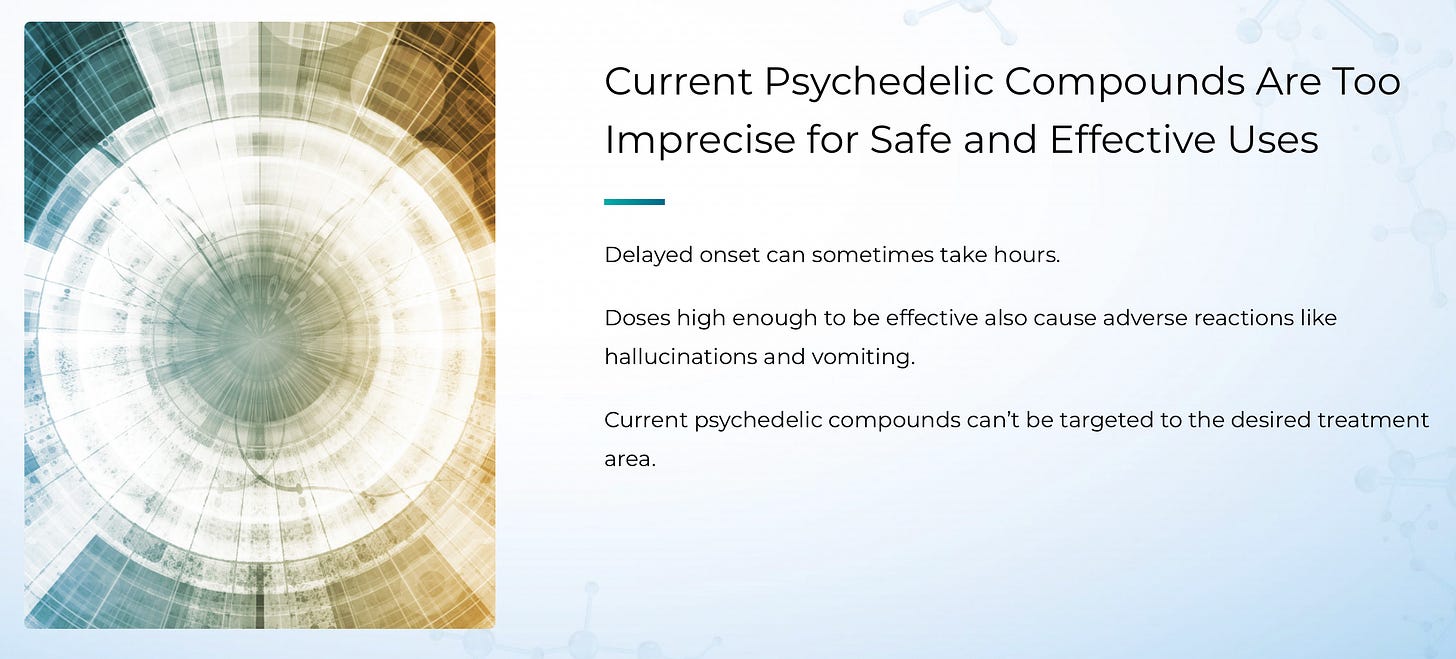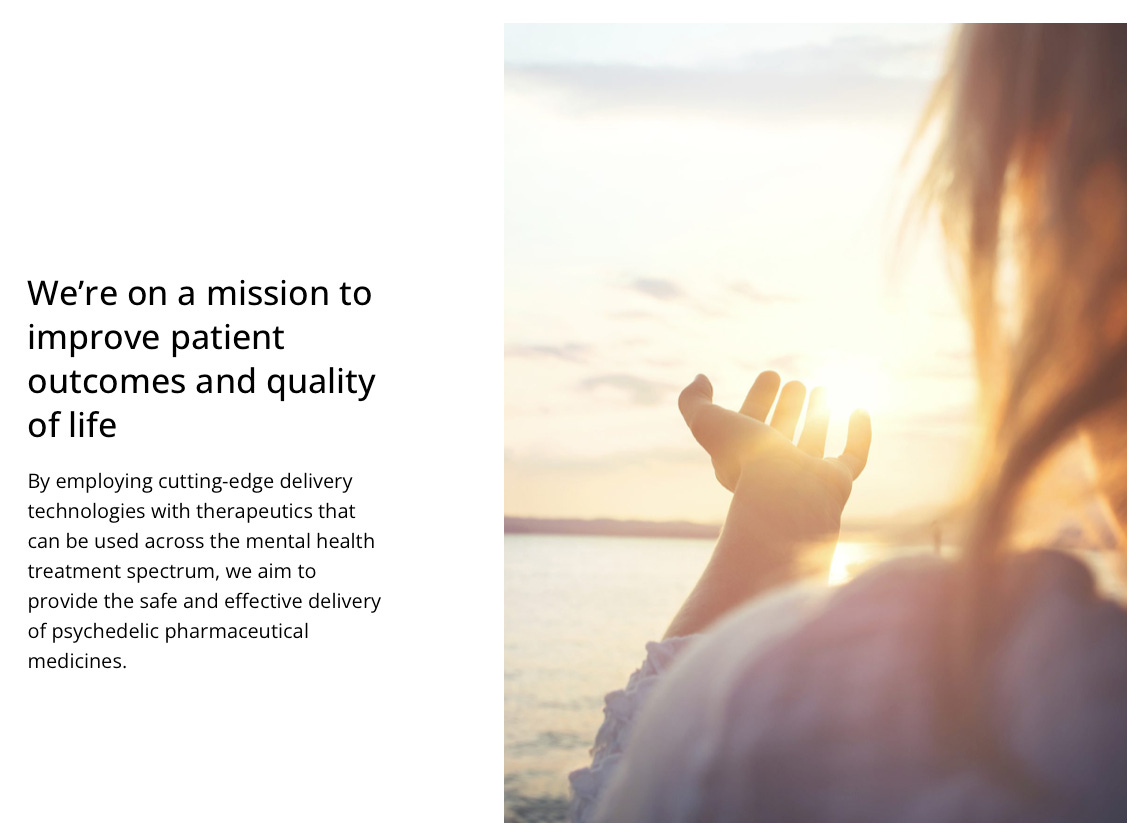Consequences of the Psychedelic Renaissance
A critical study at the intersections of psychedelics, corporate capitalism, and this moment in history
This is the seventh essay in our inquiry.
Note: This study features current and rapidly-emerging events. Our content will always be free, but we are raising funds through paid subscriptions and our 501(c)(3) fiscal host to support its continued development. Thank you for considering.
Abstract
It’s been over a half-century since the backlash to the hippie movement, and psychedelics are now gaining broad social appeal and regulatory acceptance. Optimists have deemed this era to be a Psychedelic Renaissance.
While these medicines are distinguishing in their healing potential, concerns are emerging at their intersections with corporate capitalism, institutionalized healthcare, disruptive technologies, and popular culture. Many of these developments have notably diverged from sustainable principles and are extracting from Indigenous peoples.
This study is written for public benefit, serving to inform civil society in the responsible stewardship of these powerful medicines.
_____
Part I
Corporate Origins of Modern Psychedelics
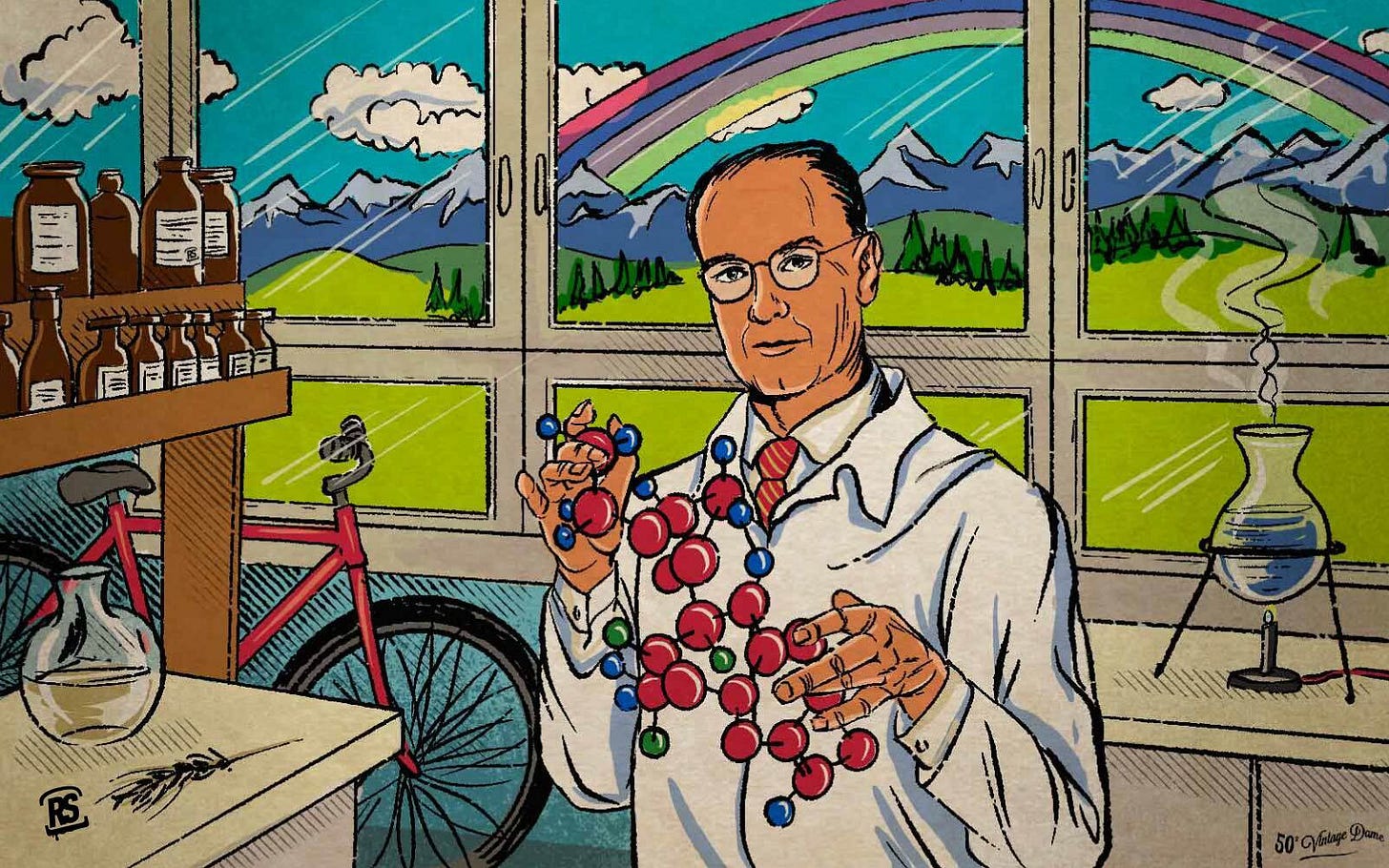
LSD was discovered in a corporate lab
In 1938, Albert Hofmann made a coincidental discovery in a lab of Sandoz, a pharmaceutical corporation. His lab had been studying variations of lysergic acid, a biologically active compound within ergot (a rye fungus) for applications in child delivery. On his 25th combination of lysergic acid compounds (LSD-25), he noted that it unexpectedly excited the mice that he was testing on.1
Five years later, Hofmann’s curiosities led him to re-synthesize LSD-25. While completing the final step of its synthesis, he was beset by a series of strange symptoms that led him to go home for the day. Retracing his steps back at the lab, Hofmann hypothesized that he had absorbed a trace of the LSD through the skin of his fingertips.2
With his curiosities amplified, Hofmann conducted a self-experiment with his LSD a few days later. He expected his dosage to be too conservative to experience significant effects, but it turned out to be 2-3 times the common dose in modern consumption. As he began to feel its effects, he asked his lab assistant to escort him home by bicycle due to World War II restrictions on automobile use. That day, April 19, 1943, is celebrated annually as Bicycle Day.3
Upon arriving home and lying down, Hofmann recalled in his journal that he experienced “the disintegration of the outer world and the dissolution of my ego,” and that he was “taken to another world, another place, another time. My body seemed to be without sensation, lifeless, strange.” He feared that a demon had taken possession of his body, mind, and soul. Concerned for his health and sanity, Hofmann called the family doctor to their home.4
When the doctor arrived, his examination noted no abnormal symptoms besides dilated eyes. Soon after, Hofmann wrote that his horrors gave way to feelings of good fortune and gratitude — that he began “to enjoy the unprecedented colors and plays of shapes that persisted behind my closed eyes.”
The following day, Hoffman wrote that he awoke “refreshed, with a clear head, though still somewhat tired physically. A sensation of well-being and renewed life flowed through me… The world was as if newly created.”
LSD later became an experimental pharmaceutical

In 1949, Sandoz began offering free supplies of LSD under the trade name Delysid to nearly any researcher who would write up their clinical observations when administering the substance. At the lab of Humphry Osmond and Abram Hoffer in Saskatchewan, Canada, Sidney Katz of Maclean’s magazine became the first journalist to experience and write about his LSD experience.5
In 1953, Osmond and Hoffer wondered about LSD as a treatment for alcohol withdrawal. Over the next decade, they administered more than 700 alcoholics with high-dose LSD treatments, reporting that around 50% of the cases resulted in sobriety for at least several months. Unlike conventional studies that focused solely on the medication, the researchers recognized that the patient’s experience was important and that psychotherapeutic methods were helpful.6
Beginning in 1963, the National Institute of Mental Health began funding wide-ranging studies with LSD at the Spring Grove State Hospital outside Baltimore. In 1965, CBS News broadcasted an hour-long special about the hospital's successful work with alcoholics called LSD: The Spring Grove Experiment. The story was immensely popular and influenced the Maryland state government’s establishment of the Maryland Psychiatric Research Center.7
The appropriation of the ‘magic mushroom’

In the 1950s, R. Gordon Wasson, a public relations executive at J.P. Morgan, and his wife, Valentina, a Russian physician, were pursuing a dedicated hobby in the study of mushrooms. Their curiosities and subsequent expeditions led to the community of María Sabina, a Mazatec curandera practicing ceremonies with medicinal mushrooms in Huautla, Mexico.
On his third trip to Huautla, Gordon Wasson and a photographer, Allan Richardson, became the first known outsiders to experience a communal mushroom ceremony. Shortly after, on the night of June 29-30, 1955, Sabina conducted a ceremony for the two men. Wasson took the medicine and journaled his experience while Richardson photographed. Sabina had asked that any pictures be kept only to the most trusted friends, but what transpired appeared to have been a betrayal and among many transgressions in his series of travels.8
Wasson landed an $8,500 contract from Life Magazine to publish a photo essay in 1957, a monetary value equivalent to over $92,000 today. Titled “Seeking the Magic Mushroom,” it was the first known usage of the term magic mushroom.9
“From the moment the foreigners arrived, the saint children lost their purity. They lost their force; the foreigners spoiled them. From now on they won’t be any good.” 10
- María Sabina
The publicity inspired an explosion of hippie activity that disrupted the harmony of Sabina's life, village, and region. She was shunned by members of her village, briefly jailed on a marijuana accusation, and her home was burned down in the times that followed.11
In 1970, Wasson published an op-ed in the New York Times that expressed regrets for what transpired:12
“Huautla, when I first knew it as humble out‐of‐the‐way Indian village, has become a true mecca for hippies, psychopaths, adventurers, pseudo research workers, the miscellaneous crew of our society's drop‐outs. The old ways are dead and I fear that my responsibility is heavy, mine and Maria Sabina's.”
- R. Gordon Wasson
In that op-ed, Wasson revealed that he had paid Sabina just 13 pesos for the ceremony that won him fame and added fortune.
Psilocybin also became an experimental pharmaceutical
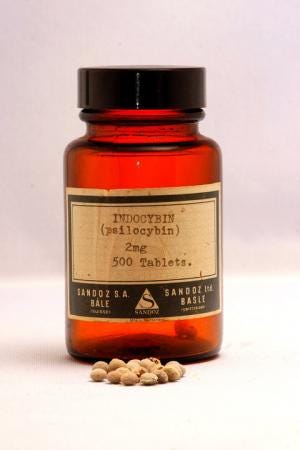
On his final expedition to Mexico in 1956, Gordon Wasson was joined by Roger Heim, a mycologist and director of the Museum of Natural History in Paris. Heim departed that visit with mushroom specimens and passed them along to Albert Hofmann, now a senior chemist at Sandoz.
In 1958, Hofmann became the first to isolate the psychoactive compounds of psilocybin and psilocin. Sandoz secured a patent for its extraction procedure and manufactured psilocybin into synthetic pills.13
In 1962, Hofmann joined Wasson on a return visit to Sabina. She and others tried the psilocybin pills and deemed them to work. His expression of gratitude was to leave Sabina a bottle of the pills, labeled Indocybin. According to Hofmann, the prefix ‘Indo-’ referenced Indians as the original discoverers of the drug and the chemical indole, which psilocybin is a derivative of. Over the next 20 years, there were anecdotal reports of its use but no clinical studies.14
The corporate origins and synthesis of mescaline
The psychedelic that became known as mescaline originates from the peyote cactus in modern-day Mexico and the San Pedro cactus of the Andes.15
The use of San Pedro has been traced beyond 1000 BCE with the Chavín culture. At the Chavín de Huántar site in Peru, archeologists have evidence that it was a temple built for large ceremonies and that San Pedro was a sacrament in their rituals. The Spanish colonists documented the use of peyote as a sacrament of the Aztecs, and it was banned in 1620 under the Inquisition.16
In 1896, Arthur Heffter isolated and named the mescaline alkaloid from his pharmacology lab in Germany. In 1919, Ernst Späth first synthesized mescaline at Vienna University. In 1920, the German pharmaceutical corporation Merck brought mescaline sulfate to market in vials designed for injection.17
Editor’s note: We integrate the corporate origins of MDMA, ketamine, and ibogaine into later sections of the study.
_____
Part II
20th Century Psychedelia
Aldous Huxley was a renowned author of the early-to-mid 20th century and a pioneering psychonaut. Decades before his first psychedelic experiences in the 1950s, he published the dystopian novel Brave New World in 1931. Among this society’s many disturbing features, an ultra-controlling World State encourages its citizens to take a happiness drug called soma to become content rather than confront the underlying problems they are experiencing.
In 1953, Huxley contacted Humphry Osmond to express interest in trying mescaline. Osmond met Huxley at his West Hollywood home to administer the taking of mescaline sulfate crystals dissolved in water. He wrote about the experience in The Doors of Perception (1954) and it was among the early works to popularize psychedelics.18
In 1956, Osmond was corresponding with Huxley about finding a better word to describe these substances than psychotomimetic, which translated to a drug that mimics psychosis. He came up with psychedelic, taking influence from the Greek words psyche (meaning ‘mind’ or ‘soul’) and deloun (meaning ‘to manifest’ or ‘to make visible’). Huxley went on to help popularize the term.
Editor’s Note: We apply the term psychedelic only for modern and Western interpretations of these medicines.
The ‘Johnny Appleseed of LSD’
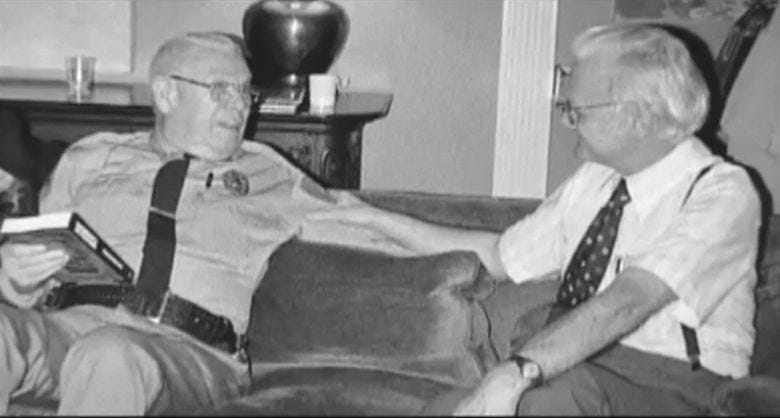
Al Hubbard became known as the ‘Johnny Appleseed of LSD’ after his first LSD experience in 1951. Born poor and with little formal education, he built himself from a busted bootlegger during prohibition into a successful businessperson with many government affiliations. Though he had no background as a researcher or therapist, he developed a methodology and convinced Sandoz to supply him with tremendous supplies of LSD. Between 1951 and 1966, Hubbard introduced an estimated 6,000 people to LSD, including members of Parliament and officials of the Roman Catholic Church.19
Before it was known as Silicon Valley, Hubbard embedded within one of the region’s earliest technology corporations, Ampex, to conduct weekly workshops and administer LSD to company executives. Out of Hubbard’s influence, the seeds for psychedelics and psychedelia spread throughout the region.20
The hippie movement and its backlash

The psychedelic events of the 1950s led to the emergence of mass psychedelia in the 1960s. For example, the actor Cary Grant emerged from his LSD therapy in 1959 claiming to be “born again.”21
During the Summer of Love in 1967, nearly 100,000 young people converged into the Haight-Ashbury neighborhood in San Francisco to manifest hippie culture. Two summers later, the Woodstock music festival in upstate New York attracted more than 400,000 attendees. In 1971, John Lennon debuted Imagine, his best-selling single written with Yoko Ono. The song’s lyrics imagine a world without violence, countries, religion, or materialism.
Also in 1971, Ram Dass (formerly Richard Alpert) published Be Here Now, a psychedelic-inspired book popularizing Eastern spiritualities and yoga. Steve Jobs cited the book and LSD as profound influences on his life.22
In a politically charged environment from the Vietnam War, the hippie movement gravitated toward a radical counterculture agenda. Timothy Leary emerged as one of the movement’s most influential figures after he was fired from Harvard alongside Richard Alpert. The League for Spiritual Discovery (LSD) was a psychedelic church that emerged out of Leary’s influence. U.S. President Richard Nixon, who was inaugurated in 1969, once called Leary “the most dangerous man in America.” 23
In 1971, Nixon launched what became known as the War on Drugs and declared drug abuse as “public enemy number one.” In the year prior, Congress passed the Controlled Substances Act, and the U.S. Drug Enforcement Agency (DEA) was established in 1973. Under this scheme, marijuana and most psychedelics were classified as Schedule I, the most prohibitive level of federal enforcement. As psychedelics became strictly illegal, the movement would go underground for decades.
The MK-ULTRA project at the CIA factored significantly in the emergence of the hippie movement and the collapse of psychedelic studies
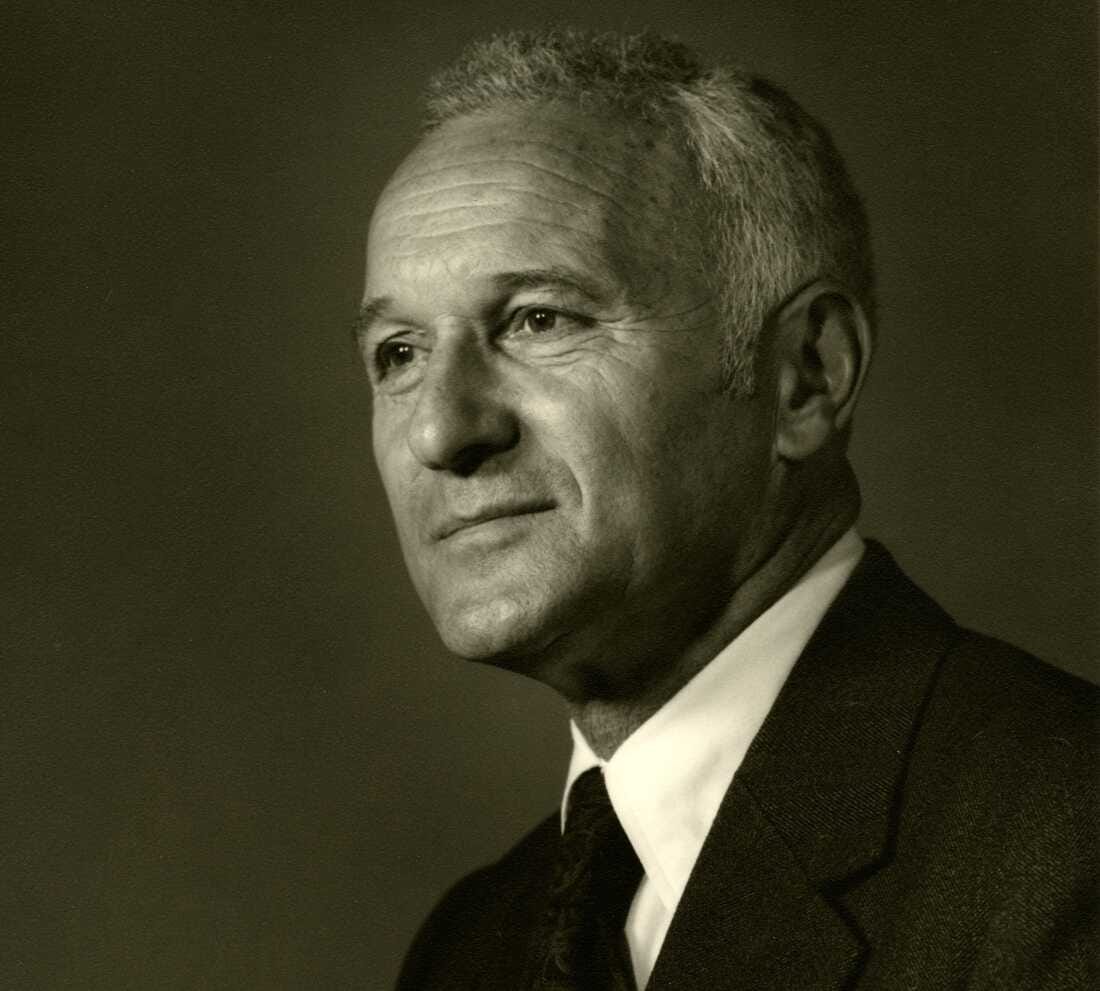
In 1975, President Gerald Ford’s Rockefeller Commission and the U.S Congress’ Church Committee revealed the MK-ULTRA project at the U.S. Central Intelligence Agency (CIA).
Conducted from 1953 to 1973, the CIA purchased massive quantities of LSD from Sandoz and distributed it under bogus foundations for research at hospitals, clinics, prisons, and universities. In the most disturbing instances, people were unknowingly dosed with LSD under experiments for mind control, where they were subject to abuse and torture. Among their test subjects were mental health patients, prisoners, drug addicts, and prostitutes. According to the journalist Stephen Kinzer, the project "was a continuation of the work begun in WWII-era Japanese facilities and Nazi concentration camps on subduing and controlling human minds." When these revelations were revealed, there was political fury to shut down all remaining LSD research.24
This project turned out to be a financier of R. Gordon Wasson. After learning about his mushroom expedition in 1955, the CIA arranged a $2,000 grant to Wasson for the visit that was ultimately chronicled in Life Magazine. Wasson wasn’t aware of the true source of the funds, as they were arranged through an academic chemist working secretly in their employ, James Moore.25
Figures who became renowned in the psychedelic movement and popular culture, including Allen Ginsberg, Ken Kesey, and Robert Hunter, were significantly impacted by these experiments.26
Amidst a government-wide panic during the 1973 Watergate scandal, CIA Director Richard Helms ordered all MK-ULTRA documents to be destroyed, so the full extent of the program couldn’t be proven when formal investigations began in 1975.27
The emergence and suppression of MDMA in the 1980s

MDMA (3,4-methylenedioxy-methamphetamine) was first synthesized in 1912 at Merck, though it was not considered then for its psychoactive qualities.28
During the late 1970s and early 1980s, MDMA re-emerged out of Alexander “Sasha” Shulgin’s experiments with psychoactive substances, which began while he was a senior research chemist with Dow Chemical.
Though MDMA has mild hallucinatory properties, it is better known as an empathogen for increasing feelings of empathy, emotional openness, and social connection. These effects make it highly conducive for patients to heal from traumatic experiences in therapeutic settings. Leo Zeff, who pioneered LSD-assisted psychotherapy in the 1960s, was introduced by Shulgin to MDMA in 1977 and went on to administer MDMA to thousands of patients.29
MDMA is also a stimulant, and the combination of its characteristics made it a popular party and love drug in the 1980s. Initially known by the street name Adam, MDMA began showing up at gay clubs in Dallas, Texas and its spread coincided with disc jockeys developing electronic dance music (EDM) for all-night parties.30
Under the Ronald Reagan administration, MDMA became effectively banned as a Schedule I drug in 1985.31
_____
Part III
Revivals of Psychedelic Legitimacy
In the latter half of the 20th century, there were enormous barriers for psychedelic studies to continue. The backlash against the hippie movement in the late 1960s resulted in the outright banning of psychedelics as Schedule I drugs in the 1970s. In the 1980s, the setbacks with MDMA reinforced those barriers.
Within these contexts, numerous figures have spent decades working to reestablish the foundations for psychedelic studies and its return to mainstream culture today.
Rick Doblin and the founding of MAPS
In 1986, Rick Doblin founded the Multidisciplinary Association of Psychedelic Studies (MAPS), a non-profit that became a front-facing institution for the Psychedelic Renaissance movement.32
In 2001, Doblin obtained a Ph.D. from Harvard’s Kennedy School of Government and published his dissertation on the “Regulation of the Medical Use of Psychedelics and Marijuana.” This research laid a roadmap for advancing psychedelics through the institutions of science and regulated medicine.33
Roland Griffiths and revivals in psychedelic science
“Where I sit as a scientist is that psychedelics are the most powerful tool we have in the scientific toolbox to understand awakening experiences.”
- Roland Griffiths
In 1999, Roland Griffiths, a psychopharmacologist with a sterling reputation as a drug addiction researcher, convinced government officials and leaders at the Johns Hopkins School of Medicine to let him initiate a research program into psilocybin.
The Center for Psychedelic & Consciousness Research at Johns Hopkins, which he founded, has since emerged as an epicenter for clinical trials and hundreds of published papers on psychedelic-assisted therapies to treat conditions such as depression, nicotine addiction, and end-of-life anxiety for people with cancer.
In 2006, he was the lead author of a landmark scientific publication that established a scientific basis for recognizing the mystical experiences that can be induced by psilocybin.34
In 2023, Griffiths faced a terminal cancer diagnosis and passed away on October 16th. In his final months, he was honored at the 2023 Psychedelic Science conference, had a televised conversation with Oprah Winfrey, and was featured in the New York Times.35
Stanislav Grof and the emergence of psychedelic-assisted therapy
In the 1950s, Stanislav Grof, a trained psychiatrist and psychoanalyst, began experimenting with LSD and exploring the therapeutic possibilities of psychedelics. In the 1960s, he applied his techniques for ‘LSD psychotherapy’ to guide individuals through intense experiences while under the influence of the substance, believing that it could facilitate access to repressed memories, unresolved traumas, and spiritual insights. In the late 1960s, Grof was among the first to form the field of transpersonal psychology, which integrates the spiritual and transcendent aspects of the human experience into the frameworks of modern psychology.36
Regulatory breakthroughs in psychedelic-assisted therapy
MDMA-assisted therapy37
MAPS is positioned as the leader in MDMA-assisted psychotherapy. In its sponsored clinical trials for patients with severe and chronic post-traumatic stress disorder (PTSD), 67% of participants no longer qualified for a PTSD diagnosis after three guided sessions in MDMA-assisted psychotherapy. Meanwhile, 88% of participants experienced a clinically meaningful reduction in symptoms. Such findings and the advocacy of U.S. combat veterans have influenced bi-partisan political support for psychedelic research and psychedelic-assisted therapies.38
Pending FDA approval in the United States
In February of 2024, Lykos Therapeutics announced that the FDA had accepted its new drug application for MDMA in combination with psychological intervention. At the time of the announcement, a target date of August 11, 2024 was set to complete the FDA approval process.39
In a potential setback, the Institute for Clinical and Economic Review released a report on March 26, 2024 that raised concerns about the quality of the clinical trials and the sufficiency of its findings. On June 4th, the Food and Drug Administration’s Psychopharmacologic Drugs Advisory Committee voted overwhelmingly against approving the therapy based on the sufficiency of available data (9-to-2 vote) and whether the benefits outweigh the risks (10-to-1 vote). The committee’s recommendations are non-binding, so Lykos will continue to lobby the FDA until a final decision is reached.40
After decades of research and activism, the achievement of FDA approval for MDMA-assisted therapy would be a watershed moment for the Psychedelic Renaissance movement and MAPS, which originally founded Lykos Therapeutics as a for-profit subsidiary called MAPS Public Benefit Corporation (MAPS PBC). We will pick up on this case in Part V (Psychedelic Commercialization).
Psilocybin-assisted therapy
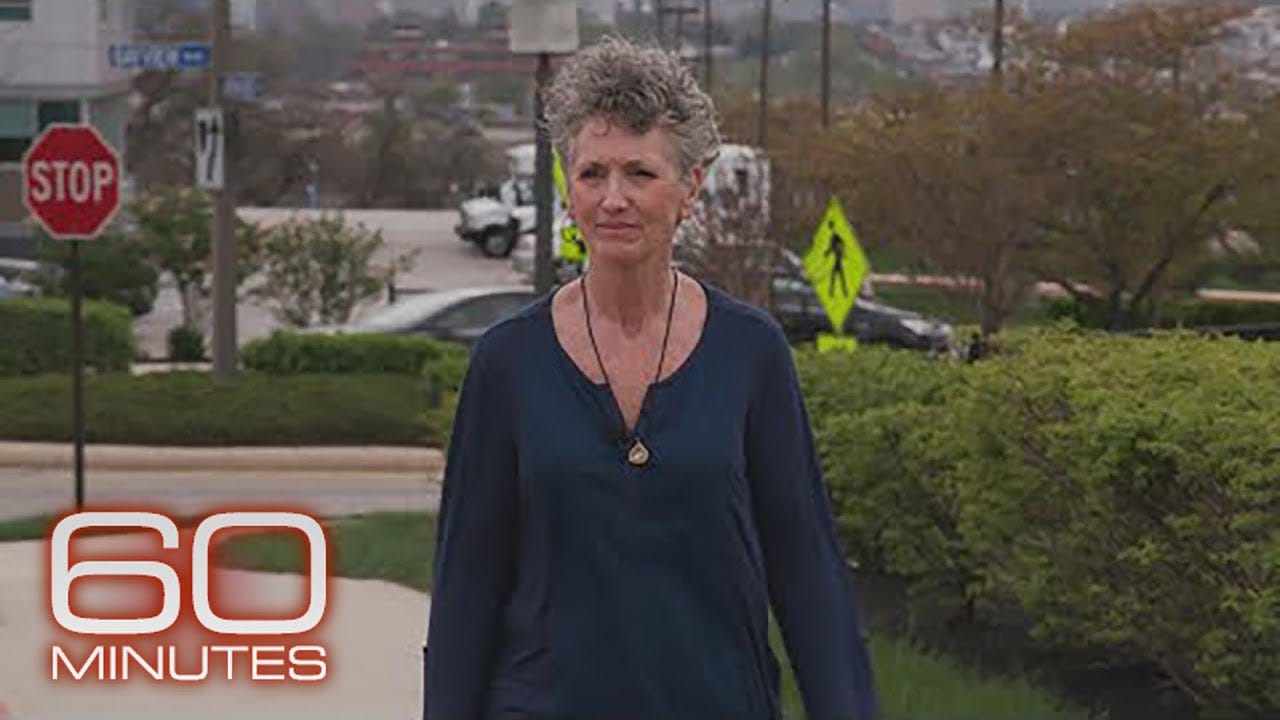
Although psilocybin originates from mushrooms, the medications that have progressed furthest in the FDA approval process are synthetic compounds. Since organic mushrooms contain a variance of psychoactive and other interacting compounds, these factors present challenges for the customs of precision science. By comparison, a synthetic molecule can be precisely isolated and dosed within a clinical environment.41
Compass Pathways, a publicly traded pharmaceutical corporation, is initiating phase 3 clinical trials toward the FDA approval of COMP360, its patented synthetic formulation. The company is also conducting phase 2 trials for COMP360 to treat anorexia nervosa and PTSD.42
On March 20th, 2024, the Usona Institute announced the launch of its Phase 3 clinical trial for a synthetic psilocybin candidate that treats Major Depressive Disorder (MDD) with psychosocial support. The institute operates as a non-profit medical research organization (MRO), which contains its focus to research.43
In 2023, Oregon became the first U.S. state to authorize the use of psilocybin mushrooms under the supervision of a state-certified facilitator at a state-licensed service facility. This authorization was preceded by the passage of Measure 109, the “Psilocybin Mushroom Services Program Initiative,” in Oregon's November 2020 election with 55.75% support. We will continue this discussion in Part VI (Systems Literacy).44
Ketamine therapy
Ketamine is an anesthetic drug that has more recently been considered a psychedelic substance. It was first synthesized in 1962 at Parke-Davis (now a part of Pfizer) and became FDA-approved in 1970. It became prominent as a battlefield anesthetic in Vietnam and is used worldwide by anesthesiologists today.45
In psychedelic medicine, it is understood to aid in the treatment of depression by facilitating the brain's ability to form new connections and repair existing ones.46
In 1999, ketamine was classified as a Schedule III drug by the DEA, which allows for medical use. In 2000, a controlled trial at the Yale School of Medicine was the first to demonstrate ketamine’s ability to improve the mood of people living with depression.47
By 2006, the National Institute of Mental Health concluded that an intravenous dose of ketamine had rapid antidepressant effects. Since 2010, U.S. physicians have prescribed ketamine off-label to patients with severe depression, which is legal with informed and consenting patients.48
Ketamine is also an addictive drug with widespread recreational use and street distribution. In December of 2023, the celebrity Matthew Perry was found unresponsive in his hot tub and pronounced dead on the scene. The toxicology results revealed that he drowned and had a dose of ketamine in his body that was equivalent to its use in general anesthesia.49
Ketamine use is reportedly common within Silicon Valley culture and its proponents include Elon Musk, who shared in March of 2024 that he uses “a small amount [of ketamine] once every other week or something like that.” 50
_____
Part IV
21st Century Psychedelia
Between the 1970s and 2010s, psychedelics continued to be used in environments that bypassed law enforcement, including college campuses, clubs, festivals, and underground therapeutic settings. More recently, psychedelia has returned to the mainstream media and widespread consumption.
Burning Man (1986-present)
“Our intention is to generate society that connects each individual to his or her creative powers, to participation in community, to the larger realm of civic life, and to the even greater world of nature that exists beyond society.”
-Our Mission (Burning Man)
In 1986, an annual fire ceremony began at Baker Beach in San Francisco, where a wooden effigy called the Man was constructed and burned. When local law enforcement intervened with the event in 1990, organizers shifted its location to a remote basin in the Black Rock Desert. Every summer, tens of thousands of people converge on the Playa to erect a temporary city featuring art, music, and a culture of radical self-reliance, self-expression, and inclusion.
In practicing the event’s principles, attendees embody a counterculture economy where gifting, communality, and civic responsibility supersede the economic norms back at home.
From these countercultural roots, Burning Man has become a mainstream attraction, with about 72,000 people attending the 2023 festival. Today’s event also features regular sightings of the rich and famous.51
Psychedelics’ return to mass media

In the 2010s, Vice Media emerged as a counterculture brand covering the psychedelic underground. With the emergence of podcasting as a platform, Tim Ferris, Joe Rogan, and Sam Harris have mainstreamed influential conversations about psychedelics. Online media organizations such as DoubleBlind, Third Wave, and Reality Sandwich have informed private consumption of these medicines and influenced popular culture.52
In 2018, Michael Pollan published How to Change Your Mind, a thorough examination of psychedelics and psychedelia that became a #1 New York Times bestseller. Pollan appeals to a broad American audience by exploring common curiosities and concerns before chronicling his first experiences with psychedelics and plant medicines.53
Psychedelia now permeates mainstream media (gallery)
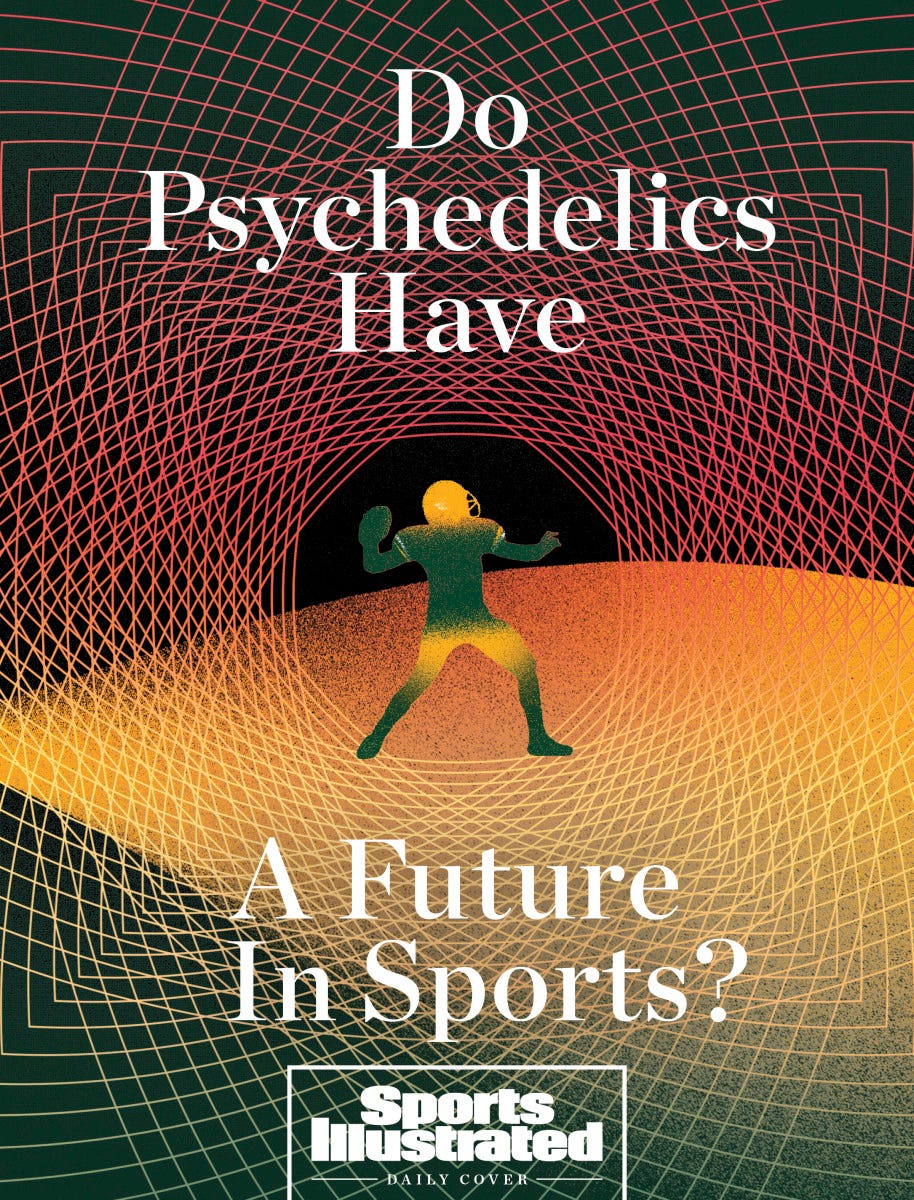

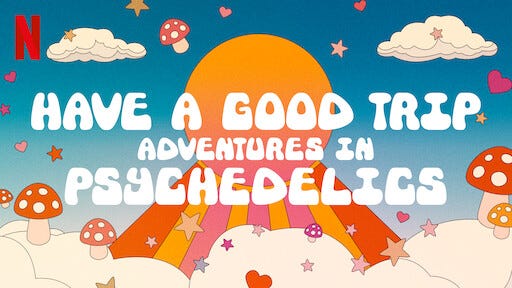


The Psychedelic Science 2023 conference
“I’m not tripping — culture is tipping,”
-Rick Doblin
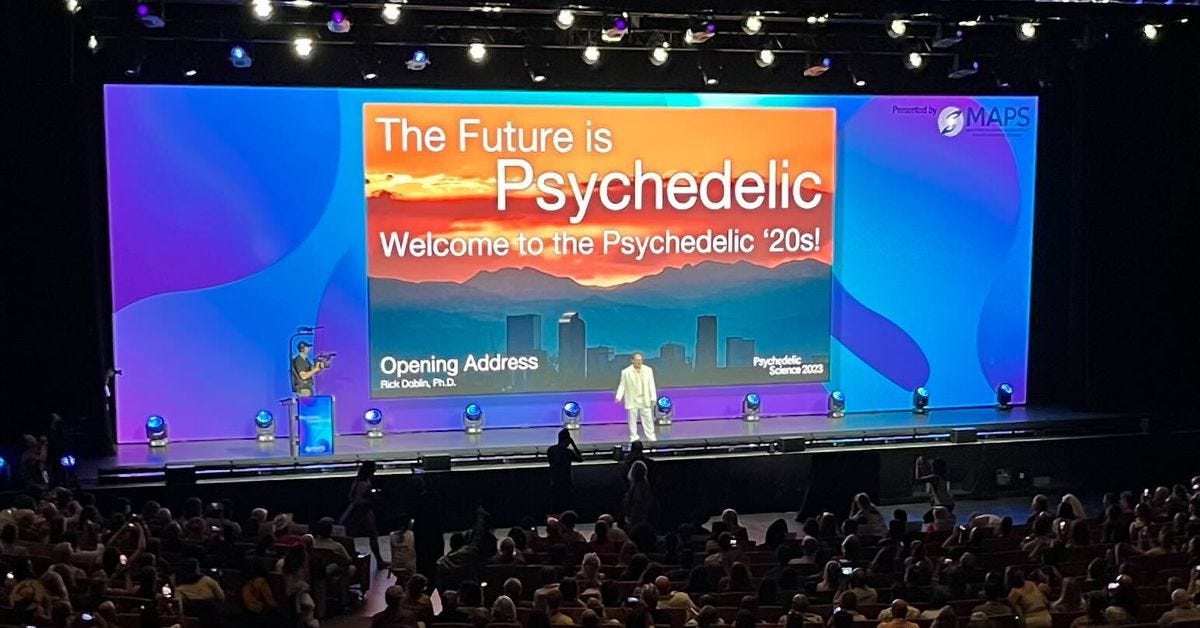
On June 19-23, 2023, over 11,000 people attended Psychedelic Science 2023, a conference and trade show produced by MAPS. It is believed to be the largest psychedelic conference in history.54
At the opening for the event, guest speakers included Rick Perry, the former Texas governor, Jared Polis, the Colorado governor, and Joshua Gordon, the director of the National Institute of Mental Health. Honored attendees at the conference included Roland Griffiths and book signings by Stanislav Grof and Michael Pollan. Celebrity attendees included Aaron Rodgers, Jaden Smith, and Melissa Etheridge.55
In his opening remarks, Rick Doblin heralded the “Psychedelic ‘20s” as the decade where psychedelics become mainstream across political, generational, religious, ethnic, and other identities. His vision included the training of psychedelic therapists around the world and psychedelic clinics in every community.56
In that speech, Doblin also headlined a vision for Net-Zero Trauma worldwide by 2070. With psychedelics on the brink of achieving mainstream normalization, Doblin is setting sights on a larger social vision in which the psychedelic ecosystem plays a significant part.57
Protests at the conference
As Doblin took the stage for his closing remarks to the conference, he was interrupted by a group of protestors who demanded and were granted access to the stage.
Six minutes into the protest, Kuthoomi Castro, an Indigenous activist, stepped to the podium and warned the conference audience that the Psychedelic Renaissance movement has deceived them. He spoke about Indigenous peoples watching yet another cycle of colonization play out — with Westerners disrespecting the natural use of plant medicines and the sacred traditions that Indigenous people have passed down for generations. While Indigenous peoples have opened their plant medicines for healing purposes, Westerners are privatizing and capitalizing upon them. He cited tobacco, opium, and coca as examples of plants that have been abused and led to tremendous harm by the forces of capitalism. Before stepping away from the microphone, Castro pleaded that Indigenous peoples be fully included in the conversations of the psychedelic movement.58
While Indigenous voices were represented and heard at the conference, leading private investors and companies in the psychedelic sector are pointing the movement toward extractive commercialization.
_____
Part V
Psychedelic Commercialization
“Don’t forget, the set and setting of the psychedelic renaissance is free-market capitalism.”
-Jamie Wheal

In 2019, David Alder published We Will Call It Pala (2019), a fictional short story where a commercialized future for psychedelics goes awry. In the story, a young woman sets out to change the world for good after psychedelic experiences profoundly impact her. She starts up a company specializing in psychedelic-assisted therapy clinics, raises venture capital money, opens her first clinics, and sees her dreams coming true. However, she then faces the persistent pressure of growing revenues and cutting costs amidst rampant competition. Over time, her company’s quality of care becomes commodified. By the end of the story, psychedelics have become mass-marketed as a panacea, and the world is no better for it.
Commercialization of ketamine therapy
In 2020, Field Trip Health went public at a valuation of over $100 million. The company initially administered ketamine therapy through intramuscular injections in a clinical setting and pursued the rapid expansion of its geographic footprint. Later, the company launched a lower-cost hybrid program, Field Trip Freedom, to facilitate at-home sessions using ketamine tablets and an app for recorded guidance. The company collapsed in March of 2023 and has been restructuring, but it was a trailblazer in the commercialization of ketamine therapy.59
In 2019, Spravato, a nasal spray of a ketamine derivative (esketamine) was approved by the FDA for treatment-resistant depression under supervision by a medical professional in a clinical facility. It’s manufactured and marketed by Janssen Pharmaceuticals, a subsidiary of Johnson & Johnson. In 2023, the drug reached $689 million in sales on 84% annual growth. Also, in 2023, the FDA released a warning about the rising misuse of prescription ketamine nasal sprays due to rampant distribution and unsupervised treatments.60

Mindbloom is a mainstream ketamine treatment provider that brands itself as a “a leader in psychedelic therapy, transforming lives to transform the world.” 61
Through their at-home therapy program, patients are mailed a package that includes doses of ketamine as dissolvable tablets. Their six-session program consists of two consultations with a licensed clinician and three meetings with a ‘guide’. Guides are deemed to be “experts in supporting ketamine therapy,” though that expertise is deemed by the company rather than an independent authority.62
In December 2022, the Wall Street Journal reported about misleading ads for ketamine therapy flooding social media in the United States. The advertisements sell ketamine therapy as a panacea even though it is also an addictive and easily harmful drug.63
Commercialization of MDMA therapy
From its leading position in MDMA-assisted psychotherapy research, MAPS reached a point where tens of millions of dollars were needed to bring the medicine through clinical trials for regulatory approval. It would then be additional orders of magnitude to manufacture and distribute these medicines at scale. As a non-profit, those costs would quickly approach and exceed what MAPS has raised in its history.
To address these funding needs while aligning with its non-profit values, MAPS founded a for-profit subsidiary called MAPS Public Benefit Corporation (MAPS PBC) in 2014. For years, the company insisted that it could raise sufficient money for MAPS PBC without giving away governance and equity rights to the company. In 2021, the company attempted to raise $70 million while promising investors only a time-limited percentage of North American revenues. However, this effort fell far behind its goals. On January 5, 2024, the company announced the closure of a $100 million equity-based fundraising agreement with private investors and changed its name to Lykos Therapeutics. In this agreement, MAPS has reportedly retained the rights to appoint six of the eight board members and has ten-to-one voting power over unspecified activities.64
If Lykos is successful at achieving FDA approval for its MDMA-assisted psychotherapy, it will also benefit from a period of market exclusivity. MAPS (the non-profit) is also well positioned as an authority for psychedelic-assisted therapist training.
Commercialization of psilocybin therapy
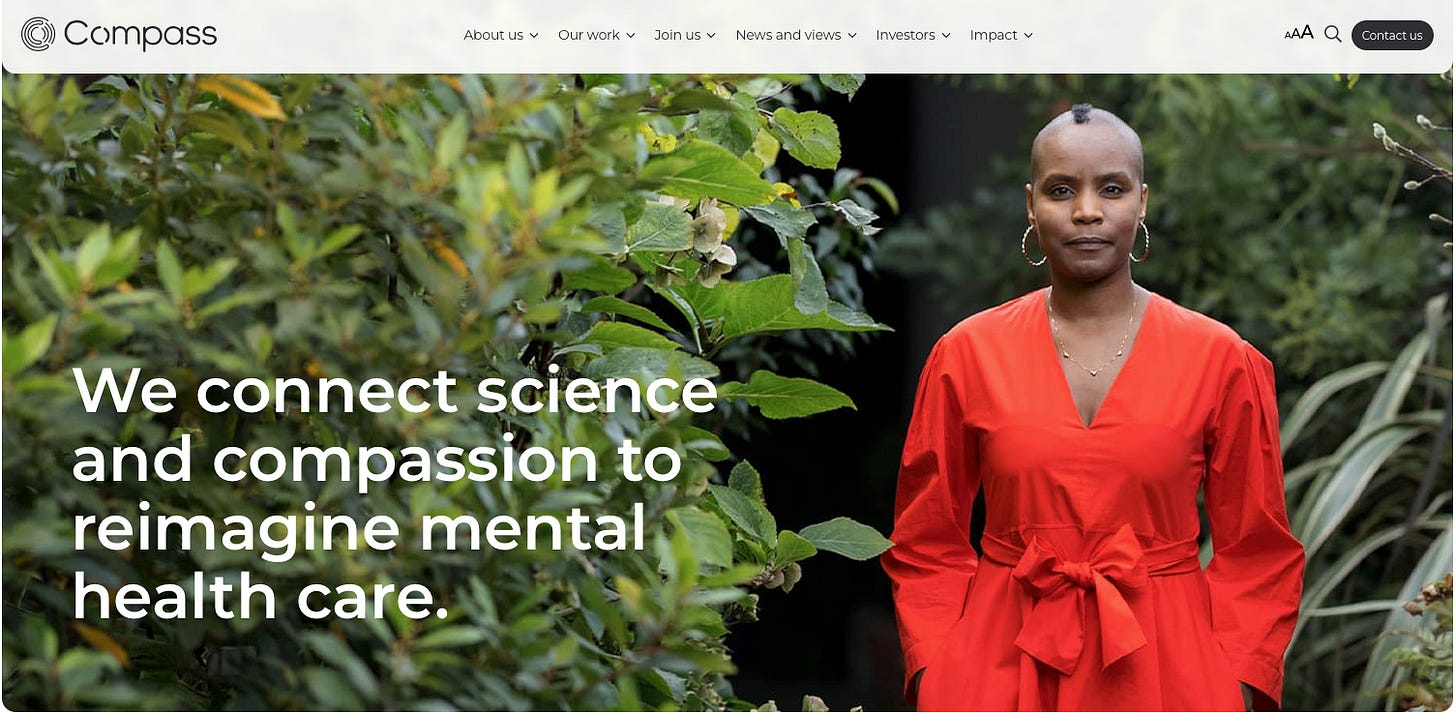
Compass Pathways is a publicly traded company with a synthetic psilocybin compound called COMP360. At the time of publication, the compound was entering Phase 3 trials for treatment-resistant depression and Phase 2 trials for post-traumatic stress disorder and anorexia nervosa.65
The company had an initial public offering in 2021, raising approximately $450 million to back its commercial pursuits. Valued currently as a $534 million company, Compass has successfully defended its patents and is preparing to accelerate its growth as a mainstream business. The company is also eligible for New Chemical Entity (NCE) protection in the United States, which grants five years of market exclusivity upon FDA approval. Its patents will be protected from competition until 2038 at the earliest. As the company turns its focus to mass commercialization, it calculates that the global market of people suffering from treatment-resistant depression to be approximately 100 million.66
Big money is highly invested in the psychedelic industry
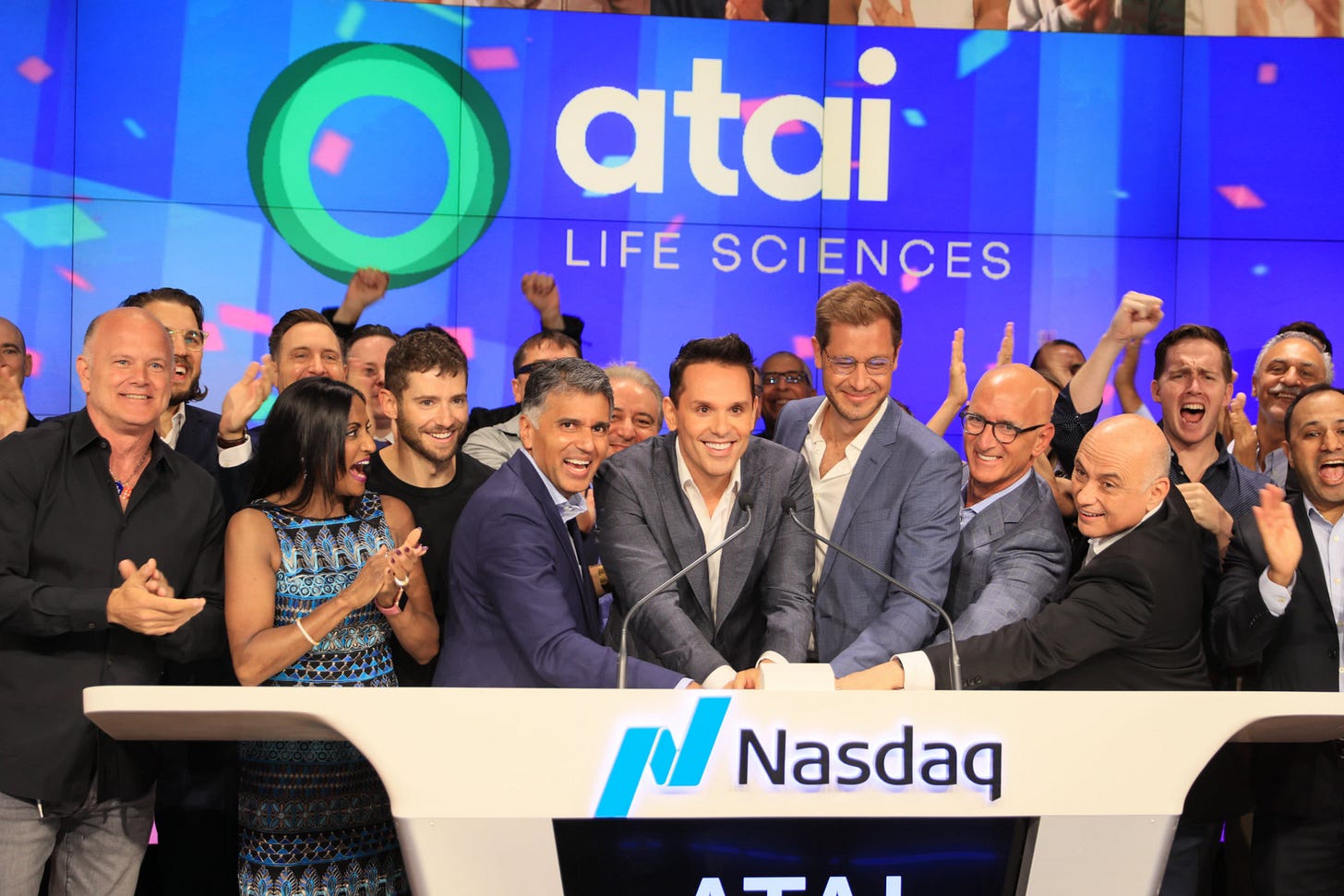
The examples of Compass Pathways and Lykos Therapeutics headline an enormous pipeline of pharmaceutical development with psychedelic medicines. The research firm Psychedelic Alpha publishes databases of the industry’s current and cumulative developments.67
Among the highest-valued companies in the space is atai Life Sciences, which is backed by billionaire investor Peter Thiel. The company went public in 2021 at a valuation of $3.19 billion, raising $225 million with its initial public offering. In late 2021, it was reported that atai had accumulated a 20.8% stake in Compass Pathways. At the time of publication, atai’s programs include Phase 2 clinical trials for a 5-MEO-DMT compound and Phase 1 clinical trials for ibogaine, DMT, psilocin, and MDMA compounds.68
The intersections of psychedelics with disruptive technologies and trans-humanistic worldviews

Christian Angermayer is the founder and chairman of atai Life Sciences. His grander vision for the psychedelic future intersects with a worldview of substantially evolving the human condition.
Angermayer and Thiel are founders and investors, respectively, in the Enhanced Games, which aims to supersede the Olympic Games with a full embrace of performance-enhancing drugs, prosthetics, and other scientifically-driven advantages.
Another scientific project that Angermayer champions is life extension. He writes on his website that he deeply believes that “aging and death are widely misunderstood.” His point is followed by challenging every religious and cultural tradition around death.69
On this trajectory, there are few restraints on the world’s wealthiest technologists making evolutionary decisions on behalf of the human race. Marc Andreessen, a leading venture capitalist, offered the following views in his 2023 essay, The Techno-Optimist Manifesto:
“We believe in accelerationism – the conscious and deliberate propulsion of technological development – to ensure the fulfillment of the Law of Accelerating Returns. To ensure the techno-capital upward spiral continues forever.”
Under the section titled “Becoming Technological Supermen”, Andreessen writes:
“We believe in nature, but we also believe in overcoming nature. We are not primitives, cowering in fear of the lightning bolt. We are the apex predator; the lightning works for us.”
Thus, the consequentiality of psychedelic science and capitalism extends not only to the actions of individuals and companies, but to systemic changes to the human condition in the image of technological acceleration and monetary accumulation. Angermayer’s writing is explicit that he aims to “usher in true superhuman abilities through the seamless integration of technology into our bodies.”70
Further reading: Drug-enhanced separation (2024) and Timothy Leary’s psychedelic eugenics (2022), by Jules Evans71
_____
Part VI
Systems Literacy
In this section, we establish a basis for practical understandings and conversations about the economies of these powerful medicines.
Capitalist models
Under capitalist models, financial investors ultimately own and control a business. Thus, the overarching purpose of a capitalist business is to make money.
Start-ups

When entrepreneurs have promising business ideas, they look to investors to raise money. In exchange for their investments, angel investors and venture capitalists negotiate a share of the company's equity and their corporate governance power.
At the intersections of psychedelic medicine, businesses are developing market opportunities using bioengineering, manufacturing, distribution, and/or marketing. In pharmaceuticals, securing patents is a prominent way to secure a competitive advantage that’s protected by the law.
Psycheceutical is one of the higher-profile startups emerging through this paradigm:
"When I see a new industry emerging, I try to pick the companies that are highly scalable. In psychedelics, that's going to be the companies focused on safety and efficacy like Psycheceutical. Psycheceutical has patented delivery systems designed to remove the hallucinogenic effects of psychedelics and deliver them with targeted dosing, which makes these compounds available to the mainstream."
- Kevin Harrington, professional and celebrity investor72
In the business of these companies, scientists and medical doctors can earn significant income by attaching their credentialed authority to capitalist viewpoints of psychedelic medicines. In the case of Psycheceutical, the company states on its website that “significant medical & technological limitations have kept [psychedelic] medications from being safe, effective, and widely accessible.” This statement entirely disregards centuries and millennia of Indigenous stewardship for consciousness-altering medicines.73
Publicly traded corporations
It can take years for a start-up effort to demonstrate its money-making potential. Early employees and investors take this risk in entrepreneurship on the potential to become wealthy and gain social status in the future.
One way to translate this risk into wealth is to sell equity on a public stock exchange. In the United States, these marketplaces are dominated by Wall Street institutions such as hedge funds, mutual funds, and index funds. Members of the public can also purchase shares directly through brokerage accounts. These are legally-bounded financial arrangements rather than ethical ones.
In this case study, we featured atai Life Sciences and Compass Pathways as leading public companies. In a directory compiled by Psychedelic Alpha, there are 49 publicly traded psychedelic companies developing drugs and therapy solutions at a combined valuation of around $2 billion.74
Through the financial might of these institutions, the capitalist model can easily dominate other models of economic exchange. In the United States, this money can be maneuvered to elect and lobby politicians, saturate airwaves with advertising, and misinform the public that it’s mission-driven rather than profit-driven. A range of such statements are exhibited in the footnotes.75
Corporate capitalist models that embed social purpose(s)
This category distinguishes corporations with legal structures and governance practices that substantiate a social purpose in their everyday decision-making.
Public Benefit Corporations (PBC)

A Public Benefit Corporation (PBC) is a corporation that obligates itself to serve social or environmental benefits alongside its profit motive. These benefits are stated in its articles of incorporation, which are filed under state-level agencies in the United States. At the time of publication, 36 states and the District of Columbia have passed legislation recognizing public benefit corporations as legal business entities.
B Lab is a non-profit leader in establishing Benefit Corporation standards. While specific standards vary by state, the general characteristics of a benefit corporation are its commitments to:76
Purpose: Declaring its public benefit(s) in its articles of incorporation.
Accountability: Expanding the board’s obligations to consider its public benefit(s).
Transparency: Reporting its progress to achieve its public benefit(s).
Note: B Lab also administers the B Corp Certification standards.
Lykos Therapeutics (formerly MAPS PBC) is set to be first-to-market with MDMA for regulated therapies. The company states in its original incorporation document from 2014 that:
“…the special purpose of the corporation is to balance social benefits with profits in developing, promoting and facilitating the careful medical and legal uses of psychedelics, marijuana, and other approaches to modifying consciousness, for the benefit of the public.”
The Lykos website markets four tenants of being a public benefit corporation and three areas of focus: people, governance, and innovation. On June 6th, 2024, we reached out to the company for commitments that are legally-binding or embedded in its governance bylaws.77
Steward-Ownership and Trust Agreements
Steward-ownership is an umbrella term for corporate structures that ensure ownership remains in the firm and profits serve the company’s mission rather than private gains.
A Perpetual Purpose Trust (PPT) is an agreement that can commit a business to prioritizing a non-financial purpose throughout the duration of the entity. Under the arrangements of this trust agreement, the designated trustees are legally obligated to steward the Trust’s designated purposes.
Case example: Journey Colab
Journey Colab is a biopharmaceutical startup that is testing a synthetic mescaline compound for treating alcohol use disorder.
Since becoming aware of mescaline in the 20th century, Westerners have mass-extracted the peyote cactus to make it a threatened species. These practices have especially harmed the Indigenous communities that have worked sustainably with the plant. Journey Colab is seeking to mitigate and repair this issue through its approaches.
Structured within the corporation is the Journey Reciprocity Trust, a perpetual purpose trust that holds 10% of the company’s founding equity. The Trust is governed by its Trust Stewardship Committee (TSC), which is responsible for accomplishing the Trust’s purpose and functioning as an Impact Advisory Board for the company. The Trust’s five appointed members are tasked with representing underserved and disadvantaged communities, especially Indigenous communities, with the designated purposes of expanding access to care, conserving the ecologies and traditional uses of naturally occurring psychedelics, and benefiting non-profit partners in the psychedelic space.78
Dive deeper: For the Psychedelic Science 2023 conference, the author partnered with North Star, a non-profit in the psychedelic sector, to publish the North Star Business Guide: Structures and Practices for Purposeful Organizations.
Open science
“From generations of practitioners and researchers before us, we have received knowledge about these substances, their risks, and ways to use them constructively. In turn, we accept the call to use that knowledge for the common good and to share freely whatever related knowledge we may discover or develop.”
- Statement on Open Science and Open Praxis with Psilocybin, MDMA, and Similar Substances
Open science is a broadly defined movement that seeks to make scientific research and its dissemination accessible to all levels of society. Within the psychedelic sector, the active leadership of both the Usona Institute and MAPS Public Benefit Corporation (now Lykos Therapeutics) are signatories of the statement that’s quoted and linked to above. The statement commits to four principles, summarized here as:79
1. Intellectual and scientific integrity: Reporting truthful research results, even when they are disappointing or adverse.
2. In service: Committing to public good over private gain.
3. Open science and open praxis: Signatories will not exploit their discoveries, methods, and best practices for commercial advantages, and their data will be managed for the public good rather than for private gain.
4. Non-interference: Signatories strive to publicize their discoveries and license their intellectual property for reasonable administrative costs.
Should the Usona Institute achieve FDA approval for its synthetic psilocybin candidate, it remains to be seen how that medicine will be sufficiently manufactured and distributed to qualified therapy practices.80
Local economic models
Small business clinics
Ketamine therapy
While larger corporations such as Field Trip Health and Mindbloom have pursued ketamine therapy through national footprints of branded clinics and at-home care, another model is where clinics are locally owned and operated.
A common challenge in the medical settings of ketamine therapy is a lack of training in the holistic aspects of psychedelic-assisted therapy. In its Ethical Guidelines for Ketamine Clinicians, the KRIYA Ketamine Research Institute integrates the responsibilities of mental health professionals, medical professionals, and patients in the conduct of appropriate care.81
Psilocybin therapy
In Oregon, the consumption of organic psilocybin is regulated under the supervision of a licensed facilitator. To be licensed, facilitators must complete a training program, pass a state-level exam, and pay an annual licensure fee of $2,000. Rather than diagnosing and treating medical conditions, facilitators are responsible for overseeing psilocybin sessions and ensuring that participants remain safe. Oregon’s facilitator process requires a preparation session before the administration session, and they are encouraged to offer integration sessions where clients can also be referred to continued support services.82
Note: Many U.S. states and localities are highly active in the decriminalization and regulation of psilocybin. Psychedelic Alpha sustains a tracker of those activities.
Footnote: Schools that specialize in psychedelic-assisted therapy.83
Community groups
Within many urban centers of the United States, there are community groups that inform those interested in the responsible use of psychedelic substances. These groups can operate publicly if they do not promote illegal activities. The Global Psychedelic Society organizes and connects over 300 groups at local levels.
In New York City, the Brooklyn Psychedelic Society (BPS) is a non-profit organization founded in 2015, initially as an informal community. Upon developing a reputation, it became a fiscally sponsored project by MAPS. Since March 11, 2024, it has been operating as an independent 501(c)(3) non-profit organization. The organization describes itself as a “democratically-governed healing community” aiming to create an open-source framework for community-based healing. In the organization’s vision, a clear regulatory, ethical, and operational structure will exist for licensed facilitators to offer community ceremonies. If facilitators can support a group of people at a time, the costs become much more accessible.
In the history of psychedelia, group consumption has been the norm in recreational settings such as college campuses, festivals, private clubs, and public parks. Should proper regulations and standards be in place, there would be higher integrity options for groups of people to work with these powerful medicines.84
Religious communities and church models
Under Western organizational structures, the church model has been emerging as a way for communities practicing ceremonies to obtain legal and non-profit recognition for their organized activities.85
Native American churches
The Native American Church (NAC) is a decentralized organization that uses peyote as its sacred sacrament. The church originated in the Oklahoma Territory in the late 19th century, a period in which hundreds of tribes, including those with peyote traditions, were forced onto reservations and succumbed to continuous pressure from Christian missionaries. Under these conditions, the NAC emerged out of blending native sacraments, traditions, and values, sometimes with aspects of Christianity. Structurally, the NAC consists of loosely affiliated local chapters rather than a centrally governing organization.
When the U.S. Congress passed the Controlled Substances Act of 1970, it included the banning of peyote as a Schedule I substance. It took several years for the NAC to regain recognition and access to their sacrament under the American Indian Religious Freedom Act (1978).86
Dive deeper: The Indigenous Medicine Conservation Fund is a philanthropic fund that works to “ensure the resilience of [Indigenous] Peoples in the face of cultural appropriation, environmental extractivism, human rights violations and climate change.”
In the footnotes: The Oklevueha Native American Church is an unaffiliated offshoot that offers membership (controversially) to people without Native American descent.87
The Religious Freedom Restoration Act
In 1993, the U.S. Congress passed the Religious Freedom Restoration Act (RFRA). Following an unfavorable Supreme Court case in 1990 against two NEC members, this legislation helped establish new guidelines for churches to seek protection from seizures and prosecution under the Controlled Substances Act. These exemptions are granted on a case-by-case basis, and interpretations can vary across the U.S. district court system.88
In the 2000s, following the federal seizure of ayahuasca from a União do Vegetal (UDV) church in New Mexico, the RFRA was cited to protect the church’s religious import and use of the medicine. That case escalated to a unanimous Supreme Court ruling in 2006 that ruled in the church’s favor. In 2009, that case was cited by a district court to protect a Santo Daime church operating in Ashland, Oregon from federal prosecution for its religious ayahuasca use.89
Following the 2009 case, the U.S. Drug Enforcement Administration (DEA) released a document claiming to offer guidance for groups seeking exemption from its rules. Their guidance required that religious applicants cease all sacrament ceremonies while awaiting its decision, which could take years or result in no response at all. Until recently, no church has been granted DEA exemptions under this guidance.90
In 2022, the Church of the Eagle and the Condor sued the federal government on the grounds of the RFRA to use ayahuasca as its sacred sacrament. In 2024, the church announced that a settlement had been reached with federal agencies, including the DEA, to grant this use.91
Case example: Sacred Plant Alliance
When psychedelics and plant medicines became forbidden in the United States, the communities that were practicing ceremonies went underground, which means that they continued their practices privately and in secret from the law. The Sacred Plant Alliance (SPA) is an organization working to legitimize and protect its member churches. The organization originated within the Chacruna Institute in 2020 with several churches wanting to establish a safe container for collaboration and self-governance through ethical standards and an accountability system. It was incorporated as an association of churches in California in 2021.
Under current statutes, the legal environment remains highly uncertain for underground churches to emerge publicly. While legislative and judicial advocacy is ongoing, the SPA primarily functions as a professional association establishing credibility for its member churches. Membership in the organizations comes with extensive criteria focused on the legal, safe, and ethical use of psychedelic sacraments in spiritual practices.92
The Sacred Garden Community in Oakland, California is one of the few alliance members that practices publicly. In 2019, the organization benefited from successful local advocacy to decriminalize entheogenic plants, including psilocybin mushrooms and other plant medicines. In 2020, the church successfully registered as a California Nonprofit Religious Corporation. Bob Otis, who founded and still leads the church, began practicing medicine work with groups in the 1980s and holds a master’s of divinity degree from the University of Chicago. Though identifying as a church, the organization emphasizes a first principle of “least dogma,” which is the “minimum belief we need to share to be a cohesive religious community.” 93
“We are open to the possibility that respectful practice with the Sacraments of our Church can bring about a direct experience of the Divine, within this lifetime.”
- Sacred Garden Community
As local- and state-level actions can open pathways for churches to emerge publicly, the federal landscape to recognize its legitimacy has stiffer obstacles. To this point, Sacred Garden has not filed for RFRA exemption. Instead, Otis and church leadership place the burden on the government to avoid interfering with its religious freedoms. Across the sector, it’s emphasized that churches have cooperative relationships with local law enforcement.94
Dig deeper:
1) Guide to RFRA and Best Practices for Psychedelic Plant Medicine Churches (Hoots and Chacruna Institute, 2021)95
2) The Association of Entheogenic Practitioners is a 60+ member organization in North America with similar aims to the Sacred Plant Alliance. According to its website, its members include clergy, clinicians, therapists, and practitioners that support approximately 200-300 entheogenic experiences per month.
Unincorporated Models
Since plant medicines have emerged from natural and Indigenous uses, their models are distinct from Western frameworks and corporate entities.
Indigenous ceremonies
A number of Indigenous traditions engage in plant medicine ceremonies through shamanism. Shamanism is a range of mystical practices that channels spiritual energies into the physical world, often for the purposes of healing.
A shaman leads and guides participants through the ceremony, and they are responsible for its safety and integrity. Shamans also tend to serve their communities as leaders, healers and spiritual guides.
In Breaking Open the Head (2002), Daniel Pinchbeck introduced Western audiences to shamanism through diverse experiences with different Indigenous traditions and plant medicines. His experiences revealed both the diversity and some commonalities of these traditions. Along with the consumption of plant medicine, other common elements are the use of fire in nighttime ceremonies, chanting, singing, drumming, and ritual substances that can be smelled or tasted. His explorations also revealed a deep connection to nature, aligning with the emphasis of Indigenous traditions to live in harmony with the natural world.
Westerners have flocked to foreign countries to access ceremonies with Indigenous shamans. In Pinchbeck’s book, he experiences peyote ceremonies with the Huichol people in Mexico, ayahuasca ceremonies with the Shipibo people in the Peruvian Amazon, and iboga ceremonies with the Bwiti people in Gabon on the west coast of Africa.
A 2021 study published in Scientific Reports adapted conventional clinical approaches to study the effects of ayahuasca use in its ceremonial contexts. Focusing their study on personality measurements, the study found notable declines in self-reported measures of neuroticism. The study also contributes methodology around understanding medicinal use in natural and Indigenous settings.96
At the intersections: The Soul Quest Ayahuasca Church of Mother Earth in Orlando, FL, takes a more commercialized approach to the church model and shamanistic ceremony.
The decriminalize nature movement and private consumption
In his research for How to Change Your Mind, Michael Pollan joined Paul Stamets, a renown mycologist, at a park in the Pacific Northwest to forage for medicinal mushrooms. However, since psilocybin possession is illegal, they are careful to avoid the sight of law enforcement. In the Botany of Desire (2001), Pollan recalls a story from the early 1980s when an experiment growing marijuana goes better than expected, with plants exceeding eight feet tall towering in his Connecticut backyard. After requesting a delivery of wood to his property, he learns that the man delivering it is the town’s chief of police. Had the police chief found Pollan’s marijuana plants, it would have been sufficient to seize his house and land, and sentence him to a minimum five-year prison sentence.
Under different circumstances and fortunes, these men would have become another statistic of non-violent convicted felons in the United States. Rather than contributing to the economy in their creative and productive capacities, showing up for their families, and participating in their communities, they’d be locked away in the jail system as a burden to society. With a criminal record, access to employment would have been restricted for the rest of their lives.97
In 2018, a study led by Matthew Johnson and Roland Griffiths at Johns Hopkins concluded that psilocybin fits the risk parameters of a Schedule IV substance rather than Schedule I of the Controlled Substances Act. At Schedule IV, substances are deemed to have “low potential for abuse and low risk for dependence.” Despite this scientific evidence, psilocybin and other comparably harmless plant medicines remain classified as Schedule I today in the United States. This classification is harsher than the classifications given to fentanyl, cocaine, and methamphetamine, which are Schedule II.98
Case example: The Decriminalize Nature movement
The Decriminalize Nature movement advocates for an “unalienable human right” to develop one’s relationships with nature. On the issues, the movement specifically advocates for the decriminalization of entheogenic plants, including psilocybin mushrooms, peyote, ayahuasca, and iboga.
Decriminalization typically occurs locally, where officials pass measures that minimize the police priority and penalty for possessing these medicines. With decriminalization, the focus is on protecting the rights of individuals to make personal choices in their relationship with plants.
Gift economies are a common means of exchange within decriminalized settings. Avoiding monetary exchange and its legal ramifications, medicines are given away or shared as a part of communal consumption.
Distinguishing terms
Decriminalization is distinct from legalization, in which the government actively regulates the production, distribution, sale, and use of a medicine. In Oregon’s 2020 election, Measure 109 (the Psilocybin Mushroom Services Program Initiative) created a pathway for regulators to develop the licensing and facilitator standards for legalizing psilocybin access and consumption.
The decriminalization of plant medicines is also distinct from decriminalizing drugs more generally. During the same 2020 election, Oregon voters passed Measure 110 to decriminalize all non-commercial possession of a controlled substance, which includes substances such as cocaine, heroin, and fentanyl. While the measure was intended to steer resources from drug criminalization to drug treatment, state auditors found that only 1% of people who received citations for drug possession sought help via the state’s hotline. Meanwhile, the state has seen a surge in public drug use and overdose deaths alongside growing rates nationally. Researchers are unsure whether Oregon’s law is at fault, but state leaders passed a repeal that would instead charge a minor drug offense with a new “drug enforcement misdemeanor.” This new designation will go into effect September 1, 2024.99
Black markets involve the commerce of substances that are deemed illegal. In the view of a government, this trade is criminalized because it happens outside of the purview of its regulation and taxation authorities. Black market behavior can range from a college student selling cannabis to a violent street gang selling crack cocaine. While the pharmaceutical medicine system promotes its commitment to safety, nearly every desirable drug out of the industry has found its way onto black markets for people who cannot afford or access these substances legally. When criminalization is an ineffective deterrent for black market activities, a significant public burden comes into effect by channeling people through the police, court, prison and rehabilitation systems.
Facing the American opioid crisis
According to the U.S. Centers for Disease Control and Prevention (CDC), over 75% of the 107,000 overdose deaths in the country in 2021 involved opioids. These death rates, which are steadily rising, are highly correlated with the rise in synthetic opioid use.100
The poppy plant, which can be processed into opium, has been long understood as a powerful medicine. Its uses are recorded throughout history and in many cultures, often with medical, recreational, and sometimes religious intentions. The medicine has also been a source of health and social issues across history, as it is addictive and can be harmful to the point of fatality at higher doses. In the 19th century, Britain used the opium trade to sedate and dominate the Chinese empire. In addition to the human harm it caused at the time, the trade and resulting Opium Wars led to Chinese concessions such as the ceding of Hong Kong. In Chinese history, this period is known as the “century of humiliation” and factors significantly into the state’s modern nationalism.101
In modern use, the effects of opiates have taken on more significant consequences. Fentanyl, which is a fully synthetic opioid, is approximately 50 times more potent than heroin and 100 times more potent than morphine. Thus, its improper use is far likelier to harm people. Major opiate manufacturers such as Purdue Pharmaceutical and Johnson & Johnson, distributors such as McKesson and AmerisourceBergen, and retailers such as CVS and Walgreens have all been legally implicated for their roles in the American opiate epidemic.102
Iboga and ibogaine
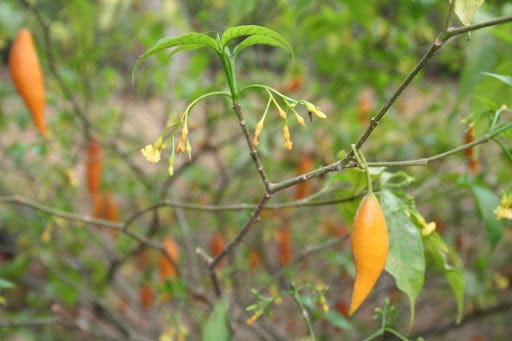
Iboga is a West African-based entheogenic plant that has been proven beneficial as an opiate detoxification treatment. Indigenously, the plant has been used for rites of passage ceremonies in the Bwiti tradition led by a nganga, a highly experienced spiritual practitioner. Its psychoactive alkaloid has been isolated and is being pharmaceutically developed as ibogaine.103
In its responsible use, ibogaine has been studied to reduce both the dependency and withdrawal symptoms of opiates, alcohol, and other substances. In 1962, a 19-year-old named Howard Lotsof brought attention to the medicine when he personally claimed and then studied the medicine’s ability to heal heroin addiction. However, it was not long after that the medicine became listed among the original Schedule I substances. At the time of publication, pharmaceutical companies are actively developing, patenting, and conducting clinical trials of ibogaine and similar compounds. There are greater risks of side effects with ibogaine, especially with cardiovascular health, so there are additional obstacles to overcome in the drug development and clinical trial processes. On March 14, 2024, Gilgamesh Pharmaceuticals was awarded a $14 million grant from the National Institute on Drug Abuse (NIDA) to develop a cardiac-safe ibogaine medicine for treating substance abuse disorders. 104
As demand for Iboga has expanded beyond Bwiti ceremonies, it’s been increasingly poached out of Gabon’s forests and smuggled out of the country to the medical tourism industry. A non-profit called Blessings of the Forest is leading the development of a fair trade program for Gabonese growers and communities. Their program adheres to the Nagoya Protocol, a United Nations agreement that went into effect in 2014. The protocol aims to share the benefits of genetic resources with the people and places they originate from.105
_____
Conclusion
Integrating the Case Study

Origins of the Psychedelic Renaissance
The term Psychedelic Renaissance is credited to the title of a 2012 book by Ben Sessa, a medical doctor. In the early 2000s, Sessa was training as a child psychiatrist in the United Kingdom and became fascinated with clinical psychedelic therapy. He wrote a report that became the first published paper in the British medical press on psychedelics since the 1960s. He went on to partner with an established drug researcher and a British financier to initiate psilocybin trials at Bristol University. By 2010, he had become a leading advocate for MDMA-assisted psychotherapy and wrote that “Rick Doblin deserves a Nobel Prize for his perseverance.” Doblin later wrote a foreword for Sessa’s 2012 book. In 2022, Sessa was featured in the MDMA episode of How to Change Your Mind, recalling the “second summer of love” in the UK in 1988 and discussing MDMA-assisted psychotherapy. In March of 2024, Sessa’s medical license got suspended in the UK following the review of a case where he engaged in a sexual relationship with a former patient who then committed suicide after they broke up. This news has cast a shadow on the psychedelic movement’s associations with Sessa and the use of his term. In 2023, MAPS featured, “Join the Psychedelic Renaissance” prominently on its homepage. We no longer see that term in MAPS’ promotional content, but it remains prominent in the commercial media. 106
An abbreviated summary of the study
While plant medicines have thousands of years of human lineages, the last 100+ years have been notable for the emergence of psychedelic paradigms in Western society. These paradigms include laboratory experiments and developments, clinical sets and settings, and cultural experiments in the arts and human behavior.
In the mid-20th century, the emergence of scientific and therapeutic studies of psychedelics was overshadowed by their mass consumption for recreational purposes and the spread of countercultural ideologies. This period was also heavily impacted by the CIA’s MK-ULTRA program. Ultimately, reactionary forces were successful at effectively banning psychedelic science and medicinal use for generations.
It’s now been over 50 years since psychedelics were forced underground. Yet, the modern psychedelic movement has been blooming as a result of career-long efforts to restore the legitimacy of these medicines. Although 1970s restrictions remain in place, a stronger coalition of support has emerged through science, business, and civil engagement. Culturally, the psychedelic movement has returned to diverse spectrums of the mainstream media.
As this study approaches the present day, it increasingly confronts the consequential intersections of psychedelics and capitalism. Unlike the spiritual traditions that have endured through extended history, the systems of capitalism place the profit motive at the forefront of developing, distributing, and marketing these powerful medicines. Since the capitalist model recognizes no limits to its size and power, corporate developments are positioned to engulf the psychedelic movement in that image. Leading investors in this industry are pursuing a worldview in which these medicines combine with disruptive technologies to substantially evolve the human condition.
This discussion led us to evaluate alternative models for stewarding these powerful medicines:
Certain corporations are regulating themselves to place specific objectives of human, social, and ecological purpose above or in equal consideration to the profit motive. Our inquiry focuses on legally obligating measures in the corporate and governance structures, which helps distinguish empty rhetoric from structural realities.
Small business clinics are administering ketamine therapy through local ownership and operation. These clinics are positioned to administer additional psychedelic medicines if they are FDA-approved.
Psychedelic-assisted therapists offer individualized and specialized care through a psychedelic experience. This model has been demonstrated to be effective in overcoming embedded traumas such as post-traumatic stress disorder.
Plant medicine facilitators are certified to offer safe and intentional environments for people to access the natural healing capabilities of these medicines.
The ceremony model expands the capacities of facilitated care through community- and church-based organizations.
Shamanism is the Indigenous form of ceremonial practice to channel the plant medicines’ mystical and healing qualities.
Private consumption extends to personal decisions around growing, consuming, and stewarding these medicines.
What’s at stake
From an anthropological perspective, millions of people are being introduced to consciousness-altering experiences with powerful medicines for the first time. This is a highly consequential development for humanity’s future.
In some sets and settings, these medicines can be extraordinary catalysts to heal inner wounds, find love, and enhance one’s connectedness with others, the natural world, and their spirituality. In others, these medicines can destabilize one’s health and relationships. A 2023 study evaluated data from 608 participants who reported extended difficulties following a psychedelic experience. The most commonly reported were emotional, social, and existential difficulties, followed by difficulties in self-perception and perception, cognition, somatics, and behavior. Among the leading factors for these negative experiences were a lack of preparation, psychological support, and disagreeable social or physical environments.107
At the intersections of capitalism, the development and services of psychedelic medicines become structurally obligated to serve unbounded financial motives. Through this frame, a natural medicine such as psilocybin must be converted into a product or service that can be sold for a profit. These capitalist models take on extraordinary power because their financial advantages disproportionately influence scientific, economic, and political priorities in the United States. Through marketing and public relations, public perceptions can also be steered in favor of these models. Such developments also relegate these medicines’ natural, communal, and spiritual qualities as secondary to the capitalist model. At the extremes, this study has illustrated how leading investors are steering psychedelic development towards trans-humanism.108
Ethical principles of traditional Indigenous medicine
The emergence of the modern psychedelics and psychedelia has been another cycle of colonization of Indigenous peoples and their practices. In this study, we’ve elaborated several instances where Western science and culture develop upon Indigenous medicines and customs without permission, inclusion, and reciprocity. Institutions of psychedelic science, business, and media can be worth millions or billions of dollars while Indigenous peoples endure continued conditions of abject poverty.
A 2023 peer-reviewed article formulates a set of ethical guidelines concerning the use of traditional plant medicines in Western psychedelic research and practice. These guidelines were generated from a group of global Indigenous representatives who hold positions of respect, knowledge, and advocacy for their people and plant medicines. 109
The paper culminates by presenting eight ethical principles:
Reverence for Mother Nature
Respect Indigenous ways of knowing and being
Responsibility for use, benefits, harms
Relevance of Indigenous knowledges in psychedelic medicine
Regulation of tangible and intangible uses of traditional Indigenous medicines
Reparation and sharing of benefits
Restoration of Indigenous authority
Reconciliation of Indigenous–Western relations
What is the social purpose of a psychedelic corporation?
We conclude this study by asking: what is the purpose of a psychedelic corporation?
Corporations have a long-established history within Western societies as a powerful and extractive form of economic organization. Yet in this sector, are corporations necessary when psychedelic medicines be naturally grown and stewarded within communities?
If we address this question by prosecuting psychedelic corporations, then can we fully substantiate better alternatives for stewarding these medicines?
And if we address this question by defending psychedelic corporations, then can we substantiate holistic ethical standards for responsible business in this sector?
If you’re taking on these or other questions from this study, please reach out.
Published April 2, 2024; last updated June 6, 2024 (v1.42)
v1.4: added the FDA’s Psychopharmacologic Drugs Advisory Committee’s recommendations against approving MDMA-assisted therapy for PTSD treatment.
v1.3: added settlement for the Church of the Eagle and the Condor. (April 26 - present)
v1.2: added and integrated Usona Institute’s psilocybin candidate; added section for open science; Oregon’s repeal of Measure 110; added citations. (April 7 - April 26, 2024)
v1.1: corrections about Sacred Plant Alliance and Brooklyn Psychedelic Society; several additions to the citations (April 3 - April 6, 2024)
______
Activation
About the project
corporate purpose project is a think tank that inquires into systemic economic change for the purposes of strengthening economic democracy. This is the seventh essay in our founding series.
Next steps for this study
We are raising funds through paid subscriptions (recurring gifts) and our 501(c)(3) fiscal host (one-time gifts) to further this study. This funding is needed to:
Continue research. The psychedelic field is continuously emerging at the intersections of science, business, culture, public policy, and spirituality. To sustain this study, we will need to continuously research and integrate developments in this field.
Develop programming. Students, parents, educators, spiritual leaders, organizational leaders, professional associations, and elected officials are reckoning with the responsible integration of these powerful medicines into our society. We intend to develop presentations, panels, conferences, and direct dialogue with these audiences.
Non-financial support
You can also support this study by:
Liking and sharing this post.
Bringing this study to your classroom, organization, or community.
Contributing feedback. Please present a verifiable identity so that we can correspond with trust and integrity.
Referring us to funding sources.
____
Gratitude
In alphabetical order, the following individuals are thanked for conversations, referrals, feedback, and/or encouragement that contributed to the emergence of this study.
Adam Wright, Alexandria Jones, Allison Hoots, Andrew Murray Dunn, Ben Collins, Bennet Zelner, Bob Palmer, Bobby Fishkin, Brandon Larkin, Colin Pugh, Dan Chen, Danielle Johnson, David Alder, Dave Rabin, Diane O’Neal, Don Koehler, Eli Rubin, Elsa Sze, Jenny Stefanotti, Josh Hardman, Julia Mande, Laure X Cast, Liana Sananda Gillooly, Mackenzie Shults, Mark Miller, Nick Samuels, Ross Sullivan, Sarah McKinley, Susanna Calvert, Swati Sharma, and Todd Youngblood.
Special thanks to Ben Collins and Adam Wright for reviewing full drafts of this study and offering substantial edits that benefited the final publication.
A primer on Sandoz Laboratories (Wikipedia)
Hofmann’s lab work contributed with the development of three successful pharmaceutical products:
Methergine, a uterotonic (Scientific American)
Hydergine, for dementia (Scientific American)
Dihydergot, for migraines (American Botanical Council)
In a memo to his boss, Hofmann wrote,
“Last Friday, April 16, 1943, I was forced to interrupt my work in the laboratory in the middle of the afternoon and proceed home, being affected by a remarkable restlessness, combined with a slight dizziness. At home I lay down and sunk into a not unpleasant intoxicated-like condition, characterized by an extremely stimulated imagination. In a dreamlike state, with eyes closed (I found the daylight to be unpleasantly glaring), I perceived an uninterrupted stream of fantastic pictures, extraordinary shapes with intense, kaleidoscopic play of colors. After some two hours this condition faded away.” LSD - My Problem Child (MAPS via McGraw-Hill Book Company)
Further reading: Miller, Norman, Basel: The birthplace of hallucinogenic science (BBC)
A typical LSD dose for strong and noticeable effects is 75-100 micrograms (Third Wave). Hofmann ingested 250 micrograms (Wikipedia).
Quoted segments are from LSD - My Problem Child, which are Hofmann’s autobiographical accounts.
Added detail: Hoffman’s wife and kids had been away at her parents’ home. Upon being informed by telephone that Albert was suffering a mysterious breakdown, she rushed home. By the time she arrived, Albert had sufficiently recovered to tell her what had happened. (LSD - My Problem Child)
Full citation: Pollan, Michael. How to Change Your Mind: What the New Science of Psychedelics Teaches Us about Consciousness, Dying, Addiction, Depression, and Transcendence. New York, Penguin Press, 2018, p. 143.
The October 1953 issues of Maclean’s magazine reads, “My 12 hours as a madman: Sidney Katz tests an experimental drug and explores the terrifying world of insanity.” (Image source: Sutori)
Researchers initially described LSD as a psychotomimetic, a mind drug that mimics psychosis (Pollan, M. How to Change Your Mind, pp. 145, 147-149.)
Hearing about this research, the co-founder of Alcoholics Anonymous, Bill Wilson, connected with LSD researchers at the Brentwood Veterans Affairs hospital in Los Angeles. He underwent several LSD sessions there but was unable to convince his board to condone the use of the substance.
Hill, Amelia. LSD could help alcoholics stop drinking, AA founder believed (The Guardian, 23 Aug, 2012)
Lattin, Don. Distilled Spirits: Getting High, Then Sober, with a Famous Writer, a Forgotten Philosopher, and a Hopeless Drunk. University of California Press, 2012.
Read about Gerald Heard, a mentor to Aldous Huxley and Bill Wilson (Wikipedia)
Yensen, Richard, and Donna Dryer. Thirty Years of Psychedelic Research: The Spring Grove Experiment and its Sequels. European College of Consciousness (ECBS) International Congress. Göttingen (Germany), September 24-27, 1992, 1995. (ResearchGate)
An abbreviated chronicle of the mushroom ceremony:
Pollan, M. How to Change Your Mind, pp. 110-112
A more extensive chronicle of the Wasson expeditions and transgressions:
Siff, Stephen. (2018). R. Gordon Wasson and the Publicity Campaign to Introduce Magic Mushrooms to Mid-Century America. Revue française d’études américaines, 156, 91-104. https://doi.org/10.3917/rfea.156.0091
Sections 12, 13, and 14 chronicle the agreements that appear to have been betrayed.
For 400 years, the sacramental use of the mushroom had been kept secret because the Spanish conquest had sought to crush those traditions. In 1620, the Roman Catholic Church declared that the use of plants for divination was “an act of superstition condemned as opposed to the purity and integrity of our Holy Catholic Faith.” Long earlier, the Aztecs called the mushroom teonanácatl, roughly translating to flesh of the gods. (Pollan, M. How to Change Your Mind, pp. 2, 109)
Wasson, R. Gordon. Seeking the Magic Mushroom. Life Magazine, 13 May, 1959. MAPS - Psychedelic Bibliography, https://bibliography.maps.org/bibliography/default/resource/15048.
Pollan, M. How to Change Your Mind, p. 105
The founder and editor-in-chief of Time-Life, Henry Luce, and his wife, Claire Boothe Luce, had personal knowledge of psychedelic drugs and their publications boosted psychedelic coverage before 1965 (p. 104, How to Change Your Mind).
Siff, Stephen (2015). Creating a Psychedelic Past, 1954–1960. In Acid Hype: American News Media and the Psychedelic Experience (p. 80). University of Illinois Press. http://www.jstor.org/stable/10.5406/j.ctt14jxvrz.7
CPI Inflation Calculator (Officialdata.org)
Pollan, M. How to Change Your Mind, pp. 114
Further reading: Mazatec Perspectives on the Globalization of Psilocybin Mushrooms (Chacruna)
Pollan, M. How to Change Your Mind, p. 114
Drugs: The Sacred Mushroom (New York Times, 26 Sept, 1970)
Siff, S. (2018). R. Gordon Wasson and the Publicity Campaign to Introduce Magic Mushrooms to Mid-Century America. Revue française d’études américaines, 156, 91-104. https://doi.org/10.3917/rfea.156.0091
Konstantin Gerber, Inti García Flores, Angela Christina Ruiz, Ismail Ali, Natalie Lyla Ginsberg, and Eduardo E. Schenberg. Ethical Concerns about Psilocybin Intellectual Property. ACS Pharmacology & Translational Science 2021 4 (2), 573-577. DOI: 10.1021/acsptsci.0c00171
Voser, Steven, Psilocybin vs. Psilocin: The Differences (Zamnesia, 23 Dec, 2022)
Hofmann’s account is documented within Teonanácatl: Hallucinogenic Mushrooms of North America, a 1978 book that’s based on proceedings at the Second International Conference on Hallucinogenic Mushrooms in October 27-30, 1977. It was edited by Jonathan Ott and Jeremy Bigwood (accessed through Beezone Library).
An abbreviated account is narrated in How to Change Your Mind, p. 113
Jay, Mike. Mescaline: A Global History of the First Psychedelic. New London, Yale University Press; 2019.
San Pedro is also known as achuma or huachuma. (p. 15)
There are additional cacti species with trace amounts of the mescaline alkaloid.
Bruhn, Jan G. (1973). "Ethnobotanical Search for Hallucinogenic Cacti". Planta Med. 24 (8): 315–319. doi:10.1055/s-0028-1099504.
Jay, M. Mescaline: A Global History of the First Psychedelic. pp. 14-24
Along with evidence of a relationship with San Pedro, archeologists found snuffing trays and tubes for ground up vilca seeds, which contain the psychoactive chemicals bufotenin and DMT. (p. 22)
Chavín: Art, Architecture, and Culture, edited by William J Conklin and Jeffrey Quilter, Cotsen Institute of Archaeology Press; 2008, retrieved from https://escholarship.org/uc/item/8741h6k1
Burger, Richard L. Chavin and the Origins of Andean Civilization. New York: Thames and Hudson, 1992.

Leonard, I. A. (1942). Peyote and the Mexican Inquisition, 1620. American Anthropologist, 44(2), 324–326. http://www.jstor.org/stable/663041
The term alkaloid derives from the German chemist who isolated morphine from the opium poppy in the early 19th century.
Jay, M. Mescaline: A Global History of the First Psychedelic. p. 18
Among Arthur Heffter’s contributions, (Source: Erowid)
He was the first chairman of the German Society of Pharmacologists
He was largely responsible for the first Handbook of Experimental Pharmacology
Heffter’s lab notes from 1897 (Heffter Research Institute, archived)
More on the history of mescaline: Out of Heidelberg University in Germany, neurologist and psychiatrist Kurt Bringer conducted experiments with 60 subjects, attempting to categorize differing hallucinatory states. Further studies of these effects were conducted in the late 1920s by Heinrich Klüver, a German-American psychologist at the University of Chicago. This research unveiled the geometric patterns known as form-constants. Further curiosities led to influencing artists, writers, and philosophers of the period.
Jay, Mike. A Century of Mescaline, (Chacruna Institute, 30 Apr, 2021)
The Teachings of Don Juan (1968), by Carlos Castaneda (1925-1998), was another influential book series of the period. It was also controversial.
In these books, Castaneda describes his encounters with a Yaqui Indian shaman named Don Juan Matus and the lessons he learned about shamanism, spirituality, and altered states of consciousness. The teachings emphasize the use of hallucinogenic plants as a means to gain insight and expand one's perception of reality. The books also explore themes of personal transformation, awareness, and the nature of reality.
The authenticity of Castaneda's accounts and the existence of Don Juan as a real person have been the subject of skepticism within the academic and anthropological communities. Still, the book has had a significant impact on popular culture.
Marshall, Robert. “The Dark Legacy of Carlos Castaneda.” Salon, 12 Apr, 2007
Pollan, M. How to Change Your Mind, pp. 167-168, 175-180
Pollan, M. How to Change Your Mind, pp. 175-179
Holden, Brad. Seattle Mystic Alfred M. Hubbard: Inventor, Bootlegger, & Psychedelic Pioneer (2010)
Holder, Brad. ‘Seattle Mystic Alfred M. Hubbard’ explores the random résumé of a creative, eccentric, 20th-century pioneer and LSD proponent (Seattle Times, 8 Aug, 2021)
Rabbit hole: Our research into Al Hubbard raised curiosities about a possible connection with L. Ron Hubbard (1911-1986), the founder of Scientology. We haven’t found evidence of a relationship, though the latter was born just 10 years later and published strong views against psychedelic use and drug use in general. His viewpoints are published on his website (Answers to Drugs, L. Ron Hubbard)
Pollan, Michael. How to Change Your Mind, pp. 156-57
Through therapists such as Oscar Janiger, Betty Eisner, and Sidney Cohen, the following celebrities underwent LSD therapy: Anaïs Nin, Jack Nicholson, Stanley Kubrick, André Previn, James Coburn, and Lord Buckley.
Grant, Cary. Autobiography: Archie Leach, Chapter 14 (carygrant.net)
Baer, Drake. How Steve Jobs' Acid-Fueled Quest For Enlightenment Made Him The Greatest Product Visionary In History (Business Insider, 29 Jan, 2015)
"Taking LSD was a profound experience, one of the most important things in my life… It reinforced my sense of what was important — creating great things instead of making money, putting things back into the stream of history and of human consciousness as much as I could."
-Steve Jobs in his autobiography
Timothy Leary (Department of Psychology, Harvard)
Multiple times, Leary was arrested and convicted for marijuana possession. He was briefly released via the Supreme Court’s 1969 decision, Leary v. United States. the day of his release, he announced a run for California governor against Ronald Reagan under the slogan, “Come together, join the party.” After John Lennon and Yoko Ono spent time with Leary, they emerged with Come Together as a campaign song. In 1970, Leary was imprisoned again for a different marijuana charge. (Wikipedia)
Mansnerus, Laura. Timothy Leary, Pied Piper Of Psychedelic 60's, Dies at 75 (New York Times, 1 Jun, 1996)
The tide had already turned against psychedelic studies in the mid-1960s, with figures such as Timothy Leary leaving little room to argue that boundaries could be established between scientific study and recreational use of psychedelics.
In April of 1966, Sandoz withdrew LSD-25 from circulation and turned over its remaining inventories to the U.S. government. Of the approximately seventy research programs underway, only one survived, the Maryland Psychiatric Research Center at Spring Grove. This may have been due to sustaining strong connections in nearby Washington, DC. The researchers who were at the center included Stanislav Grof, Bill Richards, and Walter Pahnke (Good Friday Experiment). (Pollan, Michael. How to Change Your Mind, p. 218)
Steven Ross, a psychiatrist and researcher, revealed that more than 1,000 clinical papers and 40,000 research participants were effectively erased from the field when American society turned against psychedelics. The American Psychiatric Association had entire meetings centered around LSD and there were six international scientific meetings devoted to psychedelics between 1950 and 1965. (Pollan, Michael. How to Change Your Mind, p. 141)
Siff, S. (2018). R. Gordon Wasson and the Publicity Campaign to Introduce Magic Mushrooms to Mid-Century America. Revue française d’études américaines, 156, 91-104. https://doi.org/10.3917/rfea.156.0091
Declassified records of CIA funding for Wasson’s exhibition (The Black Vault).
Marks, John. The Search for the “Manchurian Candidate” : The CIA and Mind Control. Times Books, 1979.
More on the cases of:
Allen Ginsberg, Ken Kesey, and Robert Hunter were all participants in MK-ULTRA experiments at the Menlo Park Veterans Administration Hospital (The CIA's Secret Quest For Mind Control: Torture, LSD And A 'Poisoner In Chief', NPR, 9 Sept, 2019)
Ginsberg went on to become an influential counterculture writer and poet.
Kesey’s experience while he was a student at Stanford influenced his founding of the Merry Pranksters and authoring One Flew Over the Cuckoo's Nest in 1962. (PROJECT MK-ULTRA, CIA FOIA)
In the summer of 1964, Kesey and his Merry Pranksters traveled the country in a psychedelic-painted school bus, organizing parties and giving out LSD. His broad spread of LSD influenced the emergence of psychedelic art and the acid rock genre, including the Grateful Dead, Jefferson Airplane, and the 1966 Trips Festival in San Francisco. (Wikipedia)
Ken Kesey, Author of 'Cuckoo's Nest,' Who Defined the Psychedelic Era, Dies at 66 (New York Times, 11 Nov, 2001)
Hunter became the lyricist for the Grateful Dead.
“Hunter was an early volunteer test subject for the MKULTRA program. He was paid to take LSD, psilocybin, and mescaline and respond on his experiences, which were creatively formative for him.” (Wikipedia, citing A Long Strange Trip: The Inside History of the Grateful Dead (2002), by Dennis McNally Broadway Books. pp. 42–3. ISBN 0767911865)
Whitey Bulger was a famous gangster who was allegedly exposed to this project while he was imprisoned at the Atlanta Penitentiary.
Bulger volunteered for what he was told was an experiment aimed at finding a cure for schizophrenia. As part of this experiment, he was given LSD every day for more than a year. He later realized that this had nothing to do with schizophrenia, and he was a guinea pig in a government experiment aimed at seeing what people's long-term reactions to LSD were. Bulger wrote about his experiences being horrific and thinking he was going insane. He wrote, "I was in prison for committing a crime, but they committed a greater crime on me."
Whitey Bulger's Notebook Chronicles LSD Prison Testing (CBS News, 7 Jul, 2011)
It has also been alleged that Ted Kaczynski (the Unabomber) was subject to psychological torture through the MK-ULTRA project while he was a sophomore at Harvard.
Pietsch, Bryan. Before he was the Unabomber, Ted Kaczynski was a mind-control test subject (Washington Post, 11 Jun, 2023)
PROJECT MK-ULTRA (CIA, Freedom of Information Act Reading Room)
Kinzer, Stephen. Poisoner in Chief: Sidney Gottlieb and the CIA Search for Mind Control.” Henry Holt and Company, 2019. https://doi.org/10.1162/jcws_r_00932.
“The CIA’s Secret Quest for Mind Control: Torture, LSD, And A “Poisoner In Chief” (NPR, Fresh Air, 9 Sept, 2019)
Weinberger, Sharon. When the C.I.A. Was Into Mind Control (New York Times, 10 Sept, 2019)
Sidney Gottlieb, 80, Dies; Took LSD to C.I.A (New York Times, 10 Mar, 1999)
Freudenmann RW, Oxler F, Bernschneider-Reif S. The origin of MDMA (ecstasy) revisited: the true story reconstructed from the original documents. Addiction. 2006 Sep;101(9):1241-5. doi: 10.1111/j.1360-0443.2006.01511.x. PMID: 16911722.
Stolaroff, Myron, Jonathan Ott, and Terence McKenna. The Secret Chief Revealed: Conversations with Leo Zeff, Pioneer in the Underground Psychedelic Therapy Movement. Multidisciplinary Association for Psychedelic Studies, 2004, https://maps.org/images/pdf/scr.pdf
According to Sasha Shulgin’s somewhat fictionalized autobiography, PiHKAL: A Chemical Love Story (1991), which he co-authored with his second wife Ann, he first synthesized MDMA in 1965 but did not perform self-trials at that time. In 1978, he co-published the first academic report on MDMA's effects on humans.
Benzenhofer, Udo, and Torsten Passie. “Rediscovering MDMA (ecstasy): The Role of the American Chemist Alexander T. Shulgin.” Addiction (Abingdon, England), 18 January 2010, vol. 105, no. 8, 2010, pp. 1355–61, https://doi.org/10.1111/j.1360-0443.2010.02948.x.
U.S Will Ban ‘Ecstasy,' a Hallucinogenic Drug (New York Times, 1 Jun, 1985)
The Psychedelic Renaissance was featured on MAPS homepage, accessed 17 Aug, 2023.
Doblin’s dissertation: Regulation of the Medical Use of Psychedelics and Marijuana (Kennedy School of Government, Harvard University, 2001)
Doblin’s story is well chronicled, including:
Prescription X, a film
Acid Test, a book
MAPS.org, his organization
“When administered under supportive conditions, psilocybin occasioned experiences similar to spontaneously occurring mystical experiences. The ability to occasion such experiences prospectively will allow rigorous scientific investigations of their causes and consequences.”
Psilocybin can occasion mystical-type experiences having substantial and sustained personal meaning and spiritual significance (National Library of Medicine, National Center for Biotechnology Information)
Griffiths RR, Richards WA, McCann U, Jesse R. Psilocybin can occasion mystical-type experiences having substantial and sustained personal meaning and spiritual significance. Psychopharmacology (Berl). 2006 Aug; 187(3):268-83; discussion 284-92. doi: 10.1007/s00213-006-0457-5. .
Selected exhibits that honored Roland Griffiths in his final months of life.
At the Psychedelic Science 2023 conference, Griffiths was honored with artwork by Alex Grey, a renown artist in the psychedelic movement.
Marchese, David. A Psychedelics Pioneer Takes the Ultimate Trip (New York Times, 7 Apr, 2023); Green, Penelope. Roland Griffiths Is Dead at 77; Led a Renaissance in Psychedelics Research (New York Times, 17 Oct, 2023)
William James, Abraham Maslow, and Anthony Sutich were also initial users of the term “transpersonal” in a psychological context.
Vich, M.A. (1988) Some historical sources of the term ‘transpersonal’. Journal of Transpersonal Psychology, 20 (2) 107-110. https://psycnet.apa.org/record/1989-31531-001
In the mid-1970s, when psychedelics were forced underground, Grof and his wife Christina developed a technique called Holotropic Breathwork, an intense breathing practice that induces altered states of consciousness without the use of substances.
Farizo, Felipe Landaeta, The Perceived Impact of Holotropic Breathwork: An Interpretive Phenomenological Analysis (2022). International Journal of Transpersonal Studies Advance Publication Archive. 48.
https://digitalcommons.ciis.edu/advance-archive/48
Sessa, B., Higbed L., Nutt D. A Review of 3,4-methylenedioxymethamphetamine (MDMA)-Assisted Psychotherapy. Frontiers in Psychiatry. 2019; 10: 138. https://www.frontiersin.org/articles/10.3389/fpsyt.2019.00138
Research sponsored by MAPS was granted Breakthrough Therapy Designation by the FDA in 2017, privileging expedited development and review process for showing a clear advantage over existing treatments in preliminary research.
FDA Grants Breakthrough Therapy Designation for MDMA-Assisted Therapy for PTSD, Agrees on Special Protocol Assessment for Phase 3 Trials (MAPS, 26 Aug, 2017)
Ellenhorn, Ross and Mugianis, Dimitri. Why is the American right suddenly so interested in psychedelic drugs? (The Guardian, 18 Oct, 2022)
Such figures include congressmen Dan Crenshaw and Matt Gaetz, Texas governor Greg Abbott, former Texas governor Rick Perry, businessman Peter Thiel, and donor Rebekah Mercer
On November 14, 2023, there was a subcommittee hearing in the U.S. House of Representative titled “Emerging Therapies: Breakthroughs in the Battle Against Suicide?”. It was covered in The Microdose (Hu, Jane. 17 Nov, 2023).
In July of 2023, Australian psychiatrists became able to prescribe MDMA for treating PTSD.
Shepherd, Tory. Australia to allow prescription of MDMA and psilocybin for treatment-resistant mental illness (The Guardian, 3 Feb, 2023)
Lykos Therapeutics Announces FDA Acceptance and Priority Review of New Drug Application for MDMA-Assisted Therapy for PTSD (Lykos Therapeutics, 9 Feb, 2024)
3,4-Methylenedioxymethamphetamine Assisted Psychotherapy for Post-Traumatic Stress Disorder (PTSD), Draft Evidence Report (Institute for Clinical and Economic Review, 26 Mar, 2024)
ICER Draft Evidence Report on Lykos’ MDMA-Assisted Psychotherapy Deems Clinical Evidence “Insufficient” (Psychedelic Alpha, 27 Mar 2024)
Breaking News: F.D.A. Panel Votes Against MDMA-Assisted Therapy for PTSD (The Microdose, 4 Jun 2024)
Historically, the FDA has followed its Psychopharmacologic Drugs Advisory Committee’s recommendations against approving a drug 67% of the time.
Daval CJR, Teng TW, Russo M, Kesselheim AS. Association of Advisory Committee Votes With US Food and Drug Administration Decision-Making on Prescription Drugs, 2010-2021. JAMA Health Forum.2023;4(7):e231718. doi:10.1001/jamahealthforum.2023.1718
Bauer, Barbara. Scientists Discover New Compounds in Magic Mushrooms: Researchers isolate ß-carbolines from several species of Psilocybe (Psychedelic Science Review, 26 Nov, 2019)
Blei F, Dörner S, Fricke J, et al. Simultaneous Production of Psilocybin and a Cocktail of β-Carboline Monoamine Oxidase Inhibitors in “Magic” Mushrooms. Chemistry – A European Journal. doi:10.1002/chem.201904363
Pipeline Overview (Compass Pathways); Psychedelics Drug Development Tracker (Psychedelic Alpha)
Our latest update on Compass Pathway’s TRD candidate is from the transcript of its investor earnings call on February 29, 2024. (Motley Fool)
From Kabir Nath, CEO: “…COMPASS continues to actively recruit both our Phase 3 COMP360 trials in treatment-resistant depression with top-line data expected this year and next. While our overall Phase 3 clinical program completion remains on track with top-line data from the 006 study expected in the middle of 2025, we are experiencing some recruitment delays in the 005 trial, which extends our guidance for top-line data from that trial into Quarter 4 of this year.”
Usona Institute Announces Launch of uAspire Phase 3 Clinical Trial Investigating Psilocybin for Major Depressive Disorder (Business Wire)
Psilocybin for Major Depressive Disorder (MDD) (uAspire) (ClinicalTrials.gov)
Following a double-blind treatment period, the treatment’s immediate efficacy will be determined after 43 days and its durability will be determined over a 1-year follow up period.
Double-blind means that neither the patient nor those administering the treatment are aware whether the medicine being consumed is the actual psilocybin or a placebo. In this case, 240 patients with an MDD diagnosis will be randomly assigned to receive a single oral dose of Psilocybin 25 mg, Psilocybin 5 mg, or inactive placebo. The immediate efficacy of the treatment will be determined after 43 days and its durability will be determined during the 1-year follow up period.
As a part of Measure 109 in Oregon, which passed with 55.75% support, counties and cities could hold subsequent elections to opt out of legalizing psilocybin.
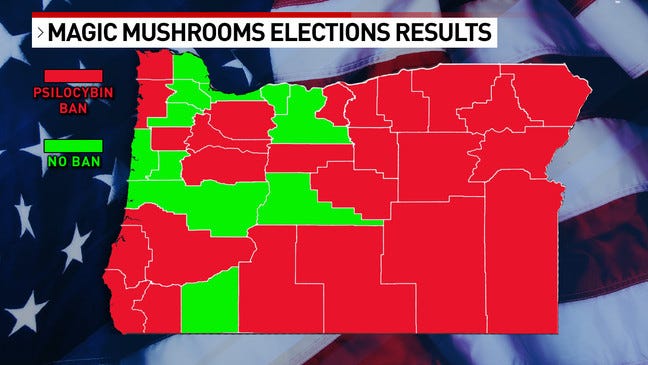
In Colorado’s November 2022 election, five Schedule I psychedelic plants and fungi were decriminalized for personal use, possession, growth, and transfer as a part of Proposition 122.
Ketamine was first synthesized in 1962 by American scientist Calvin Stevens, who was searching for an anesthetic alternative to phencyclidine, also called PCP or angel dust. The inaugural human trial of ketamine was given two years later to men incarcerated at Jackson State Prison in Michigan. The ability of those men to consent is at best debatable, which an ethical oversight explored in this article. Researchers found that at higher doses, ketamine effectively knocked people out. However, as people emerged from their anesthesia, they felt a sort of sensory dissociation, “like floating on clouds,” as if they had no arms or legs.
Mercer SJ. 'The Drug of War'--a historical review of the use of Ketamine in military conflicts. J R Nav Med Serv. 2009;95(3):145-50. PMID: 20180434.
Kopelman, J., Keller, T.A., Panny, B. et al. Rapid neuroplasticity changes and response to intravenous ketamine: a randomized controlled trial in treatment-resistant depression. Transl Psychiatry 13, 159 (2023). https://doi.org/10.1038/s41398-023-02451-0
Robert M Berman, Angela Cappiello, Amit Anand, Dan A Oren, George R Heninger, Dennis S Charney, John H Krystal, Antidepressant effects of ketamine in depressed patients, Biological Psychiatry, Volume 47, Issue 4, 2000, Pages 351-354, ISSN 0006-3223, https://doi.org/10.1016/S0006-3223(99)00230-9.
Marcantoni WS, Akoumba BS, Wassef M, Mayrand J, Lai H, Richard-Devantoy S, Beauchamp S. A systematic review and meta-analysis of the efficacy of intravenous ketamine infusion for treatment resistant depression: January 2009 - January 2019. J Affect Disord. 2020 Dec 1;277:831-841. doi: 10.1016/j.jad.2020.09.007. Epub 2020 Sep 7. PMID: 33065824.
Grinspoon, Peter. Ketamine for treatment-resistant depression: When and where is it safe? (Harvard Health Publishing, 9 Aug, 2022)
Stevens, Matt and Taylor, Derrick Bryson. Matthew Perry Died of ‘Acute Effects of Ketamine,’ Autopsy Says (New York Times, 15 Dec, 2023)
Mann, Jyoti. Elon Musk says he takes a small amount of ketamine every other week (Business Insider, 18 Mar 2024)
Grind, Kirsten and Bindley, Katherine. Magic Mushrooms. LSD. Ketamine. The Drugs That Power Silicon Valley: Entrepreneurs including Elon Musk and Sergey Brin are part of a drug movement that proponents hope will expand minds, enhance lives and produce business breakthroughs (Wall Street Journal, 27 Jun 2023)
Rogers, Taylor Nicole. Here are all the ultra-wealthy people spotted at Burning Man in 2019, from Ray Dalio in a tie-dye fur coat to mostly naked Victoria's Secret models (Business Insider, 6 Sept, 2019)
Holtermann, Callie. What Is Burning Man, and Why Have Paris Hilton and Elon Musk Shown Up? (New York Times, 3 Sept, 2023)
Maida, Stephanie. Supermodels & Celebs Got Desert Glam For Burning Man 2022 (Guest of a Guest, 7 Sept, 2022)
#psychedelics (Vice News)
Carey, Benedict. Tim Ferriss, the Man Who Put His Money Behind Psychedelic Medicine (New York Times, 6 Sept, 2019)
Psychedelics 101: Books, Documentaries, Podcasts, Science, and More (Tim Ferriss’ website, 31 Mar, 2021)
Dy, Kiki. Top 5 Joe Rogan Episodes About Psychedelics (Psychedelic Spotlight, 1 Sept, 2021)
Episode 1: Drugs and the Meaning of Life (Sam Harris’ Making Sense podcast, 4 Jul, 2011)
Erowid.org is another platform of note dating back to the 1990s.
New York Times Weekly Best Sellers (New York Times, 3 Jun, 2018)
Jarow, Oshan. The largest psychedelic conference in history is surprisingly sane. (Vox.com, 24 Jun, 2023)
Bedayn, Jesse. Aaron Rodgers, Jaden Smith and Rick Perry are all speaking out about the benefits of psychedelics at a conference in Denver (Fortune, 21 Jun, 2023)
Recordings from the conference can be accessed by registrants on the Psychedelic Science website.
The author was in attendance for the conference.
Lehktman, Alexander. Huge Gathering Seeks to Shape the “Psychedelic 20s” (Filter Magazine, 27 Jun, 2023)
We transcribed Kuthoomi Castro’s speech as follows:
“It’s so hard to be in front of here; this is very challenging.
I want you to be aware that you have been deceived by this movement…
The psychedelic renaissance is not really a psychedelic renaissance… the plant medicine is a renaissance within the Western system and it has been happening for decades through the Indigenous people. We open our medicines for you to heal, not to take…
You’re taking it. You’re colonizing it. You’re damaging us… and erasing our cultures.
Please stop. Think. Think critically. This is not OK. You are being deceived and you’re going to continue being deceived. The same happened to tobacco, now causes cancer. The same happened to opium, now causes addiction. The same happened to coca, now cocaine causes a lot of harm.
Please look at the cycle of colonization and how this continues to happen. In decades from now, you’re gonna see the medicine is harming you because they’re living beings and they don’t like to be abused…
We’re here because we love you. We’re here because we don’t want you to harm yourself. We love you. I love myself. I love my tradition. I love the Earth. And we need to study liberation together.
This is not a collective liberation movement, this is a capitalization and you’re stepping on our lands. You’re stepping on our medicines for you to heal but you’re oppressing us…
Please stop. Please think. Have conversations including us.”
Gunther, Marc. The Collapse of Field Trip Health (Lucid News, 1 Jun, 2023)
Johnson & Johnson Reports Q4 and Full-Year 2023 Results (Johnson & Johnson, 23 Jan, 2024
Jacobs, Andrew. F.D.A. Issues Warning Over Misuse of Ketamine: Unsupervised treatment — fueled by telemedicine prescriptions — for various psychiatric problems poses a number of health risks, the agency said. (New York Times, 11 Oct, 2023)
FDA warns patients and health care providers about potential risks associated with compounded ketamine products, including oral formulations, for the treatment of psychiatric disorders (U.S Food and Drug Administration, 10 Oct, 2023)
An April 2023 study published in Physiological Medicine reviewed ten clinical trials for esketamine (the Spravato nasal supplement) and found that nine of them scored as ‘low quality’ with a number of adverse events not being reported — more two-fifths of serious events and one-fifth of non-serious events.
Taillefer de Laportalière T, Jullien A, Yrondi A, Cestac P, Montastruc F. Reporting of harms in clinical trials of esketamine in depression: a systematic review. Psychological Medicine. 2023;53(10):4305-4315. doi:10.1017/S0033291723001058
“Among the ‘serious’ AEs not mentioned in the published articles and found in the patients of the esketamine group, we mainly found psychiatric but also cardiovascular (cerebral hemorrhage, hypertensive crisis), kidney, and urinary (nephrolithiasis, tubulointerstitial nephritis) symptoms. Among these psychiatric effects not found in published articles, two suicide attempts and one completed suicide were identified.”
Screenshot below from “An Introduction to Mindbloom Guides,” (Mindbloom, accessed 13 Oct, 2023)
Clinicians are “licensed medical experts in psychiatry and ketamine therapy”, and they’re responsible for the safety and proper administration of the drug. (An Introduction to Mindbloom Clinicians, Mindbloom, published 6 Dec, 2022, accessed 31 Mar, 2024)
An Introduction to Mindbloom Guides (Mindbloom, published 7 Dec, 2022, accessed 31 Mar, 2024)
Morgan, C.J.A., Curran, H.V. and (2012), Ketamine use: a review. Addiction, 107: 27-38. https://doi.org/10.1111/j.1360-0443.2011.03576.x
More reading:
Witt, Emily. Ketamine Therapy Is Going Mainstream. Are We Ready? (The New Yorker, 2021)
Hamby, Chris. A Fraught New Frontier in Telehealth: Ketamine (New York Times, 2023)
MAPS and Vine Ventures Pioneer Novel Regenerative Funding Structure to Infuse Psychedelic-Assisted Therapy Research and Access With Timely $70 Million (MAPS, 2 Dec, 2021)
MAPS PBC Closes $100m Series A, Rebrands to Lykos Therapeutics (Psychedelic Alpha, 5 Jan, 2024)
MAPS Public Benefit Corporation Announces Oversubscribed Series A Financing and Renames to Lykos Therapeutics (PR Newswire, 5 Jan, 2024)
Pipeline overview (Compass Pathways, accessed 7 Apr, 2024)
Valuation as of 17 Mar, 2024
COMPASS Pathways Announces First Quarter 2023 Financial Results and Business Highlights (COMPASS Pathways, 11 May, 2023)
Kunthara, Sophia. Compass Goes Public, CEO Says Capital Raise Goal Met (Crunchbase, 1 Apr, 2021)
Halifax, James. Compass Pathways Psilocybin Patent Upheld (Psychedelic Spotlight, 24 Jun, 2022)
Chew, K., Gamson, E., and Landsman, A. Patent Controversies in Psychedelics (Psychedelic Spotlight, 21 Oct, 2022)
Love, Shayla. Judges Deny Challenge to Psilocybin Patent (Vice News, 23 Jun, 2022)
Screenshots below from Compass Pathways’ Investor Presentation (Oct 2023)
100 million patient opportunity with TRD
Hallucinations and illusions are considered treatment-emergent adverse effects.
Compass treatment centers
COMP360 trials for anorexia nervosa
COMP360 trials for PTSD
COMP360 patent protection:
Resources from Psychedelic Alpha, a research firm:
Psychedelic Stocks & Companies: A directory of public psychedelics companies, ETFs, and private companies working in the space.
Psychedelics Drug Development Tracker: A tracker of drugs undergoing clinical trials
Psychedelic Drug Development Pipeline Bullseye Chart: A visual representation of psychedelic drug development by medicine type.
atai Life Sciences Increases its Ownership Position in COMPASS Pathways (atai Life Sciences, 29 Nov, 2021)
Thiel-backed psychedelics startup Atai evaluated at $3.19 bin in Nasdaq debut (Reuters, 18 Jun, 2021)
Our Programs (Atai Life Sciences, accessed 14 Mar, 2024)
Longevity (Christian Angermayer’s website), screenshot below accessed 27 Feb, 2024
“I deeply believe that aging and death are widely misunderstood.
For thousands of years, the conviction that aging and death are both inevitable and ‘natural’ has been integrated into our culture and woven into every religion around the globe.
- Christian Angermayer (personal website)
The future is enhanced: Structural societal changes are about to fundamentally change the future of biotech, pharma, and the wellness industry for the better. (Christian Angermayer, 23 Feb, 2024)
On the pharmaceutical side, Angermeyer is invested in a drug discovery platform that’s powered by artificial intelligence. On this premise, the rate of novel psychedelic pharmaceutical discovery can be drastically accelerated. Notable from our research, every novel and desirable psychedelic has had a disruptive effect on Western society and culture.
AbCellera Biologics, a drug discovery platform powered by artificial intelligence.
Jules Evans has actively researched the intersections of psychedelics and trans-humanism, citing the work of figures including Timothy Leary and Julian Huxley (the brother of Aldous Huxley).
Of interest to our project, Evans’s research finds the grandson of Milton Friedman (Patri Friedman) to be an active and self-described trans-humanist whose pursuits have included participating in the Future Camp at Burning Man, co-founding with Peter Thiel a project of sea-floating libertarian colonies, and supporting a pop-up city where residents are seeking to “make death optional” while exploring the intersections of bioscience, cryptocurrency, artificial intelligence, and the “disruption of governance”.
Screenshots below for the Seasteading Institute and Vitalia Project
Psycheceutical Brings on Original Shark from ‘Shark Tank,’ Kevin Harrington, as Investor and Strategic Advisor (Psycheceutical, 10 May, 2022)
Psychedelic Stocks & Companies (Psychedelic Alpha, accessed 14 Mar, 2024)
Psychedelic Funding & Public Markets in 2023 (Psychedelic Alpha, 18 Jan, 2024)
Samples below from atai Life Sciences, Psycheceutical, Compass Pathways, and Mindbloom (accessed 18 Mar, 2024)
In the United States, 36 states and the District of Columbia have passed legislation recognizing public benefit corporations as legal business entities. The organization’s bylaws for corporate governance also need to prioritize the declared public benefits.
Benefit corporation (Wikipedia, accessed 21 Oct, 2023)
Impact (Lykos Therapeutics, 6 Jun 2024)
Harrison, A & Jordan, K. How MAPS PBC Became Lykos Therapeutics and Raised $100M (Lucid News, 12 Jan, 2024)
Gunther, Marc. Shifting Strategy, MAPS Turns to Equity Investment (Lucid News, 28 Mar, 2023)
In a December 2020 blog post, leaders from MAPS and MAPS PBC published about their vision for the PBC and changing business-as-usual in the psychedelic space. (LaDou, A. & Lotlikar, K. A Wholly Public Benefit Model)
The stated purposes of the Journey Reciprocity Trust are:
Benefitting the practices and organizations working to expand equitable access to mental health care and psychedelic health care services, especially underserved and disadvantaged communities, especially Indigenous communities;
Benefitting the ecological and Indigenous cultural conservation of psychedelic medicines, with a priority for, but not limited to, the naturally-occurring compounds that Journey has developed or will develop synthetic equivalents to;
Benefitting and representing the perspectives and rights of Indigenous nations and organizations, including following best practices concerning consultation, the Nagoya Protocol, and other human rights standards concerning Indigenous groups.
Benefitting non-profit psychedelic partners.
The Journey Colab Reciprocity Trust (Journey Colab, accessed 21 Oct, 2023)
Steward ownership
What's steward-ownership? (Purpose Economy)
Steward-Ownership: Rethinking ownership in the 21st century (Purpose Economy)
Understanding the Perpetual Purpose Trust (Purpose Economy)
In September of 2022, the Patagonia company famously switched to a steward-ownership model when the Chouinard family transferred control of the company to the Patagonia Purpose Trust and their economic rights to a non-profit organization called the Holdfast Collective.
Billionaire No More: Patagonia Founder Gives Away the Company (14 Sept, 2022)
The statement originated in December of 2017 and the version we accessed was updated on January 31, 2021. (CSP)
Bennett, Raquel. Paradigms of Ketamine Treatment (KRIYA Ketamine Institute, MAPS)
Databases can be accessed through The American Society of Ketamine Physicians, Psychotherapists, and Practitioners, Ketamine Directory,
In Oregon, licenses are also required to cultivate the mushrooms, which are then tested by a licensed laboratory, and distributed only to licensed service centers, where they must remain on-site. At each layer of the supply chain, a commercial license costs $10,000 a year.
Oregon Psilocybin Service: How to become a licensed psilocybin services facilitator in Oregon (Oregon Health Authority)
Oregon Psilocybin Services: How to become a licensed psilocybin manufacturer in Oregon (Oregon Health Authority)
Oregon Psilocybin Services: How to become a licensed laboratory in Oregon (Oregon Health Authority)
Oregon Psilocybin Services: How to become a licensed psilocybin service center in Oregon (Oregon Health Authority)
Local models and costs: In Bend, Oregon, one practice operates a non-profit model where participants donate what they can afford. Their five-step process has a suggested cost of $2,300 or more. In Ashland, Oregon, we found two for-profit practices, one of which offers complete service packages for $2,000-$2,400 and another offer facilitated services as low as $1,050.
Psilocybin Services (Omnia Group Ashland); Psilocybin Therapy Services (Satya Therapeutics)
There are numerous schools with psychedelic-assisted therapy programs:
At the California Institute for Integral Studies, the Center for Psychedelic Therapies and Research offers a 10-month certificate program for those who are already licensed as mental health clinicians, specific medical professions, and ordained/commissioned clergy and chaplains. As a school of “integral studies,” it’s emphasized that the learning process is holistic and integrated across the science, history, cultural diversity, and wisdom traditions that are associated with the medicines.
The Psychedelic Research and Training Institute (PRATI) develops professional capacities in the psychedelic sector with a focus on holism. The organization currently offers trainings in ketamine-assisted psychotherapy, end-of-life & existential distress psychedelic-assisted therapy, business of psychedelic medicine, and group ketamine-assisted psychotherapy.
Other examples include programs offered through Naropa University, Beckley Academy, the Integrative Psychiatry Institute, the UC Berkeley Center for the Science of Psychedelics (facilitation), and the Columbia School of Social Work.
In a cooperative business structure, stakeholder groups own and control the business for the benefit of its members, which can be the workers, customers, or a hybrid of multiple stakeholders. The laws surrounding cooperatives vary between states, but it’s common practice to adopt the seven principles outlined by the International Cooperative Alliance:
Voluntary and open membership
Democratic member control
Members’ economic participation
Autonomy and independence
Education, training, and information
Cooperation among cooperatives
Concern for community
Cooperative identity, values & principles (International Cooperative Alliance)
In the United States, churches and other religious organizations can classify as 501(c)(3) non-profits, which enable their revenue-generating activities and donation receipts to be tax-exempt. This model is becoming increasingly relevant in the use of these entheogenic medicines for spiritual or religious purposes.
In a federal legal case (U.S. vs. Boyll, 1991), a district court judge ruled decisively in favor of a man who was transporting peyote from Mexico to his home in New Mexico as a member of the NAC. He was arrested and indicted under federal statues and argued that his First Amendment rights protected the free expression of his religion. A notable detail of this case was Boyll’s race — that he was not Native American.
“It is one thing for a local branch of the Native American Church to adopt its own restrictions on membership, but it is entirely another for the Government to restrict membership in a religious organization on the basis of race. Any such attempt to restrict religious liberties along racial lines would not only be a contemptuous affront to the First Amendment guarantee of freedom of religion but also to the Fourteenth Amendment right to equal justice under the law.” (US vs. Boyll, 1991)
Jones, P. N. (2007). The Native American Church, Peyote, and Health: Expanding Consciousness for Healing Purposes. Contemporary Justice Review : CJR, 10(4), 411–425. https://doi.org/10.1080/10282580701677477
Case example: Oklevueha Native American Church
The Oklevueha Native American Church (ONAC) is a church that serves non Native American people. They operate separately and under a distinct mission to the NAC.
A Statement of Clarification about Oklevueha Native American Church and Native American Church (NAC) (ONAC)
The organization was co-founded in the 1990s by James “Flaming Eagle” Mooney, who claimed Seminole heritage and professed to be on a mission to “take the medicine to the white man.”
Take the Medicine to the White Man: A “Native American Church” without Native Americans (Murdoch, Sierra Crane. Harper’s Magazine, June 2023)
Information about James and Linda Mooney’s Legal Journey (ONAC)
On its website, the ONAC publishes seven guiding principles, a code of conduct, and a code of ethics around membership, leadership, and the integrity of its ceremonies. The church also publishes legal standing information about its organization and has a legal defense fund. The church also distinguishes members in good standing from fraudulent branches.
List of Oklevueha Branches (ONAC)
Below is a sample membership card for the ONAC (Oklevueha Membership Application):
In the Religious Freedom Restoration Act, legislators were motivated to override a Supreme Court case in 1990 that upheld the denial of unemployment benefits to Native American Church members who were fired from their jobs for the cause of consuming peyote at a religious ceremony.
Employment Division, Department of Human Resources of Oregon v. Smith, 494 U.S. 872 (U.S. Supreme Court, 1990)
Gunther, Marc. As Plant-Medicine Churches Grow, Legal Questions Linger (Lucid News, 25 Aug, 2022)
In Gonzales v. O Centro Espírita Beneficente União do Vegetal (2006), the UDV sued for protection after the U.S. government seized its ayahuasca. The federal government argued under the Controlled Substances Act that the medicine has health risks and a risk for abuse. The church argued that the Religious Freedom Restoration Act established their right to use ayahuasca as a sacred sacrament. The church won a preliminary injunction from the district court in New Mexico, a decision that was upheld by the Tenth Circuit Court of Appeals. In the unanimous 8-0 decision, the U.S. Supreme Court affirmed UDV’s case for exemption to the CSA. (Oyez)
This case was cited as precedent to a 2009 case protecting a Santo Daime church in 2009. In that decision, a U.S. District Court judge in Oregon sided with the Church of the Holy Light of the Queen, a Santo Daime group. The judge in that case cited two sequential qualifiers:
The plaintiff must prove that government actions are burdening its exercise of religion
The government must be unable to prove its compelling interest and that it is implementing the least restrictive means to enforce its policy.
In Canada, there has been extensive work to legitimize the Santo Daime religion and the import of its sacred sacrament (ayahuasca). Rev. Dr. Jessica Rochester has worked at the intersections of religious studies and transpersonal psychology to pioneer many current developments.
Rochester, Jessica, et al. “Entheogens and Psychedelics in Canada: Proposal for a New Paradigm.” Canadian Psychology = Psychologie Canadienne, vol. 63, no. 3, 2022, pp. 413–30, https://doi.org/10.1037/cap0000285.
Gunther, Marc. Churches are providing psychedelics to their followers. Is that legal? (Medium)
Guidance Regarding Petitions for Religious Exemption from the Controlled Substances Act Pursuant to the Religious Freedom Restoration Act (DEA, revised November 2020)
“7. Activity Prohibited Until Final Determination. No petitioner may engage in any activity prohibited under the Controlled Substances Act or its regulations unless the petition has been granted and the petitioner has applied for and received a DEA Certificate of Registration. A registration granted to a petitioner is subject to subsequent suspension or revocation, where appropriate, consistent with CSA regulations and RFRA.”
Hoots, Allison & Whiting, Rebecca Lee. Chacruna Institute Files Amicus Brief in Support of Sacramental Churches’ Rights under RFRA Appeal (Chacruna Institute, 20 Oct, 2023)
The Church of the Eagle and the Condor Reaches a Settlement with Federal Agencies Affirming the Religious Right to Use Ayahuasca (Chacruna Institute, 22 Apr, 2024)
Church of the Eagle and the Condor et al v. Garland et al (FOIA Project, 9 Jun, 2022)
Membership Criteria (Sacred Plant Alliance)
Kennedy, Merrit. Oakland City Council Effectively Decriminalizes Psychedelic Mushrooms (NPR, 5 Jun, 2019)
“As we are engaged in sincere religious practice, the burden is on the government to avoid interfering with our practice. To date, formally petitioning the government has required churches to stop their sacred practices while the petition is considered… Churches have waited for years with no response.” -Bob Otis, Sacred Garden Community church
Lattin, Don. All Entheogens Welcome at this Post-Modern Oakland Church (Lucid News, 23 Nov, 2022)
Gunther, Marc. As Plant-Medicine Churches Grow, Legal Questions Linger (Lucid News, 25 Aug, 2022)
Chacruna Institute for Psychedelic Plant Medicines & Hoots, A. (2021). Guide to RFRA and Best Practices for Psychedelic Plant Medicine Churches. San Francisco, CA: Chacruna Institute for Psychedelic Plant Medicines. https://chacruna.net/guide_rfra_best_practices_psychedelic_churches/
Weiss, B., Miller, J.D., Carter, N.T. et al. Examining changes in personality following shamanic ceremonial use of ayahuasca. Sci Rep 11, 6653 (2021). https://doi.org/10.1038/s41598-021-84746-0
A Living Death: Life without Parole for Nonviolent Offenses (ACLU, 2013)
Agan, Amanda, and Sonja Starr. 2017. The Effect of Criminal Records on Access to Employment. American Economic Review, 107 (5): 560-64.DOI: 10.1257/aer.p20171003
Matthew W. Johnson, Roland R. Griffiths, Peter S. Hendricks, Jack E. Henningfield, The abuse potential of medical psilocybin according to the 8 factors of the Controlled Substances Act, Neuropharmacology, Volume 142, 2018, Pages 143-166, ISSN 0028-3908, https://doi.org/10.1016/j.neuropharm.2018.05.012.
Rush, Claire. With Oregon facing rampant public drug use, lawmakers backpedal on pioneering decriminalization law (Associated Press, 23 Jan, 2024)
Lugo, Diane. Gov. Tina Kotek signs bill reintroducing criminal penalties for drug possession in Oregon (Salem Statesman Journal, USA Today, 1 Apr, 2024)
The repeal of key aspects of Measure 110 does not impact the Measure 109, which created the regulations for psilocybin facilitation in Oregon.
Understanding the Opioid Overdose Epidemic (Centers for Disease Control and Prevention)
Metcalf, Mark. The National Humiliation Narrative: Dealing with the Present by Fixating on the Past (Association for Asian Studies, 2020)
Fentanyl (DEA)
Examples of state-level settlements:
Opioid settlements: Ending New York's opioid crisis (New York State Attorney General)
Opioid Settlement (Kentucky Attorney General)
About the Opioid Settlements (Texas Opioid Abatement Fund Council)
Corkery JM. Ibogaine as a treatment for substance misuse: Potential benefits and practical dangers. Prog Brain Res. 2018;242:217-257. doi: 10.1016/bs.pbr.2018.08.005. Epub 2018 Oct 12. PMID: 30471681.
Piotr Popik, Phil Skolnick, Chapter 3 - Pharmacology of Ibogaine and Ibogaine-Related Alkaloids, Editor(s): Geoffrey A. Cordell, The Alkaloids: Chemistry and Biology, Academic Press, Volume 52, 1999, Pages 197-231, ISSN 1099-4831, ISBN 9780124695528, https://doi.org/10.1016/S0099-9598(08)60027-9.
Koenig X, Hilber K. The anti-addiction drug ibogaine and the heart: a delicate relation. Molecules. 2015 Jan 29;20(2):2208-28. doi: 10.3390/molecules20022208. PMID: 25642835; PMCID: PMC4382526.
Hevesi, Dennis. Howard Lotsof Dies at 66; Saw Drug Cure in a Plant (New York Times, 17 Feb, 2010)
Ibogaine Patent Tracker (Psychedelic Alpha)
Psychedelics Drug Development Tracker (Psychedelic Alpha)
Gilgamesh Pharmaceuticals Awarded $14 Million National Institute on Drug Abuse Grant to Advance Novel, Cardiac-Safe Ibogaine Analog for the Treatment of Opioid Use Disorder (Gilgamesh Pharmaceuticals via PR Newswire, 14 Mar, 2024)
Nuwer, Rachel. This psychoactive plant could save lives—and everyone wants to cash in (National Geographic, 8 Mar, 2023)
Busby, Mattha. Dr. Ben Sessa Gets Suspended From Practicing Psychiatry for Sexual Misconduct (Double Blind, 7 Mar, 2024)
Evans, Jules. What are the ethical implications of the Ben Sessa case? (Ecstatic Integration, 5 Mar 2024)
How to Change Your Mind, Chapter 3, MDMA (Netflix, 22:20 for the Ben Sessa segment)
Hadar, A., David, J., Shalit, N., Roseman, L., Gross, R., Sessa, B., & Lev-Ran, S. (2023). The Psychedelic Renaissance in Clinical Research: A Bibliometric Analysis of Three Decades of Human Studies with Psychedelics. Journal of psychoactive drugs, 55(1), 1–10. https://doi.org/10.1080/02791072.2021.2022254
Adegbesan, Angel. LSD, Ecstasy Lure Traders Betting on ‘Psychedelic Renaissance’ (Bloomberg, 28 Mar, 2024)
The Psychedelic Renaissance was featured on MAPS homepage, accessed 17 Aug, 2023.
Evans J, Robinson OC, Argyri EK, Suseelan S, Murphy-Beiner A, McAlpine R, et al. (2023) Extended difficulties following the use of psychedelic drugs: A mixed methods study. PLoS ONE 18(10): e0293349. https://doi.org/10.1371/journal.pone.0293349
Dolan, Eric W. New study pinpoints the most common long-term challenges after psychedelic use (Psypost, 18 Nov, 2023)
Additional perspectives that complement the study:
Beiner, Alexander. The Bigger Picture: How Psychedelics Can Help Us Make Sense of the World (2023)
Cormier, Zoe. The Brave New World of Legalized Psychedelics Is Already Here: And so are the profiteers. Get ready for Psychedelics Inc. (The Nation, 21 Mar, 2022).
Davies, James & Pace, Brian & Devenot, Neşe. (2023). Beyond the psychedelic hype: Exploring the persistence of the neoliberal paradigm. Journal of Psychedelic Studies. 7. 10.1556/2054.2023.00273. https://akjournals.com/view/journals/2054/7/S1/article-p9.xml
Ladha, Alnoor and Suša, Rene. Why the “Psychedelic Renaissance” is just Colonialism by Another Name (Double Blind, 29 Nov. 2022)
Pace BA and Devenot N (2021). Right-Wing Psychedelia: Case Studies in Cultural Plasticity and Political Pluripotency. Front. Psychol. 12:733185. doi: 10.3389/fpsyg.2021.733185
Peck, Jules. Psychedelics for systems change: could drugs help us save the planet? (Open Democracy, 15 Feb, 2020)
Sharma, Swati. On Sacred Reciprocity: Giving Back to our Indigenous Predecessors in the Psychedelic Movement (Psychedelic Spotlight, 11 Oct, 2021)
Zelner, Bennet. Psychedelic Pharma Has Arrived—But Will It Really Be Different from Big Pharma? Psychedelic businesses have an opportunity to disrupt existing paradigms with regenerative economic practices. The question is: will they take it? (Double Blind, 20 Feb, 2023)
Celidwen, Yuria, et al. Ethical Principles of Traditional Indigenous Medicine to Guide Western Psychedelic Research and Practice. Lancet Regional Health - Americas (Online), vol. 18, 2023, pp. 100410–100410, https://doi.org/10.1016/j.lana.2022.100410.




